1lumen selects and reviews products personally. We may earn affiliate commissions through our links, which help support our testing.
Amutorch DM90S review
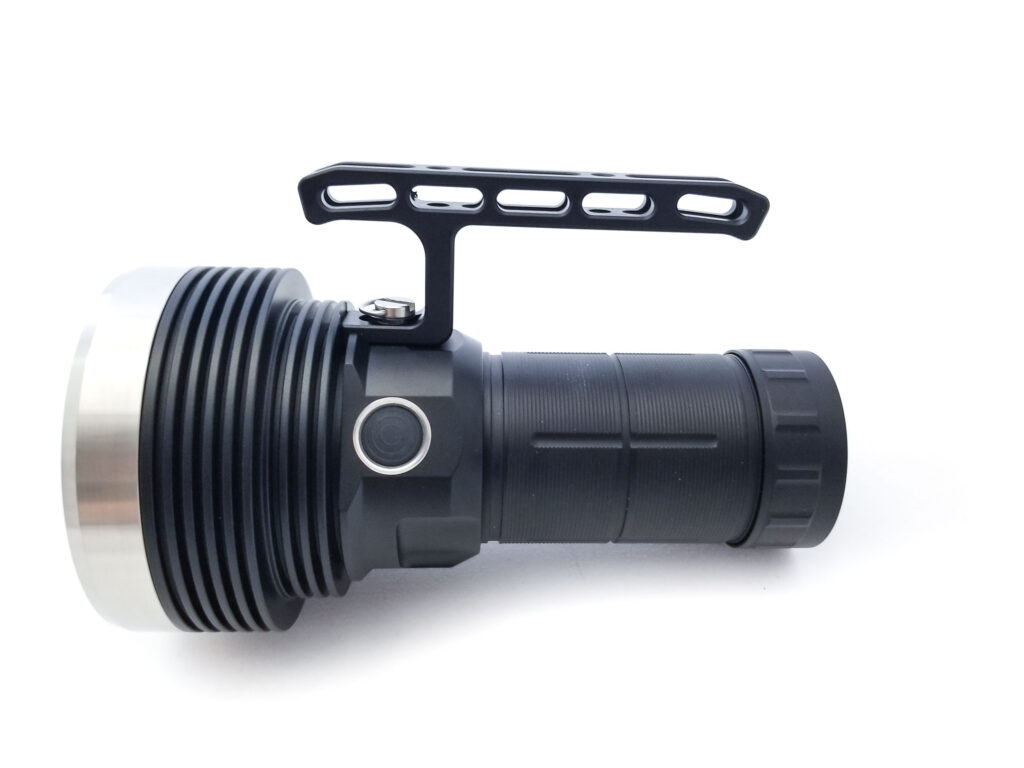
Amutorch DM90S specs
| Brand & Model | Amutorch DM90S |
|---|---|
| Flashlight category | Thrower |
| LED | RC90 |
| Max. output | 3500 lm |
| Max. beam distance | 1600 m |
| Max. beam intensity | 640,000 cd |
| Battery config. | 1*46950 |
| Onboard charging | USB type C with adapter |
| Main modes | 4+smooth ramping |
| Blinkies | Strobe |
| Waterproof | IP68 |
| Review publication date | October 2023 |
Review intro:
Amutorch. Despite delivering some interesting, affordable, and high performance flashlights, they’re still a bit of an obscure brand that gets lost in the maelstrom of Lumintop, Fenix, Olight, and Hank lights. That’s a shame because I really like Amutorch products. They strike a nice balance of quality and performance at a reasonable price. They started in 2008 on the whim of a chap named Amu, who needed a flashlight. The current ones were cheap and barely usable, or usable but too expensive. Amutorch was the result Amu’s quest to conquer the middle ground of price vs. performance and features! I’ve reviewed several Amutorches over the years, and came away mostly satisfied with them.
Thanks to Neal of Nealsgadgets, I’m able to present to you a new-ish Amutorch, the DM90S. I’ve reviewed the DM90, the full-size SBT90.2 mega thrower, and the ‘S’ comes in a smaller host with less performance overall. This one comes in two flavors, and features a somewhat unknown LED to the flashlight nexus, and a definitely unknown battery. Read on for more.
Package quality.
I don’t expect nice packaging from budget Chinese flashlight manufacturers. Most of the time I get a box, with a flashlight and some bits inside. That’s how the DM90S came, in a box with the Amutorch logo on it, a configuration sticker, and not much else. Here’s what I got:
- Amutorch DM90S flashlight
- Amutorch branded 32,000 mAh 46950 battery
- Lanyard
- 2 spare o-rings
- USB type C cable
This is a ready-to-go kit, and you can get the DM90S with or without the battery. Mine came with the battery, and I’m glad it did. And yes, you read that right…32,000 mAh. Read on for more on that. However, it was missing a critical piece of the battery puzzle that sidelined this review for a while. More on that later.

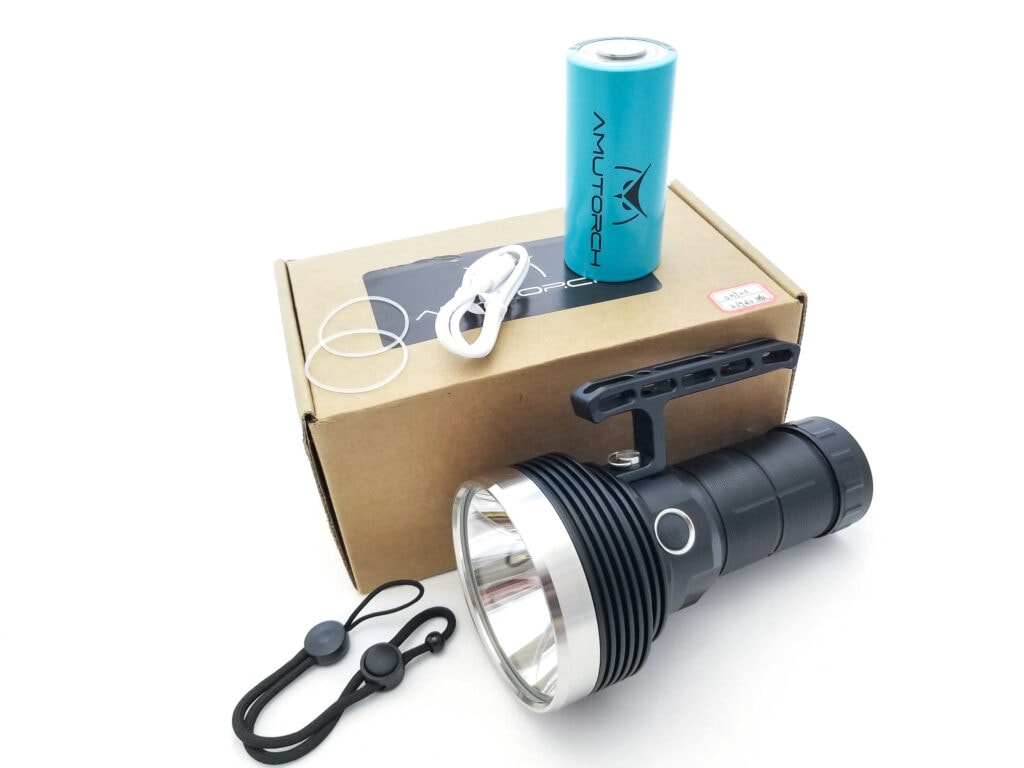
Flashlight in use, Build Quality, and Warranty
The DM90S is a long-range thrower flashlight. Smaller than a BLF GT or Acebeam K75, but bigger than a Convoy 3x21D. It’s not very good for much else due to the very focused beam hotspot and the bright spill, but in a pinch it could do general purpose use.
Like the DM90 and DM80 I reviewed, the DM90S has a detachable carry handle to help with toting it around, which is a nice addition. It also keeps your hands away from the hot bits during extended use. The handle is skeletonized with cutouts for weight reduction.
Form-factor wise, this is a soda or soup cap style light, featuring a short battery tube with a wide, flat base. The dimensions are similar to the DM80, with a roughly 90 mm head. There’s reeding for grip on the tube, and vertical grooves on the rear for gripping. The battery tube unscrews to access the battery. There’s no carrier for this DM90S due to the humongous battery (no room!). The screw hold for the handle is threaded for ¼ UNC, so you can mount it to a tripod.
There’s a single, large e-switch for switching duties lifted from the DM90 and DM80. It sits at an angle and is easily accessed when using the handle, which is very nice. It sits in a shiny aluminum bezel and sticks up a bit, so finding it was easy by feel. The boot is translucent with some aux LEDs underneath for on state and battery status (they aren’t illuminated on standby).
Tail standing was easy-peasy and super stable, which is mission-critical for a light like this for area illumination, and it won’t roll off an incline with the handle attached. There’s no lanyard holes, but you can thread the lanyard through the swiveling bail on one of the handle screws or the cutouts in the handle.
Amutorch lights occupy the middle rungs of the price/quality ladder, similar to something you’d get from Sofirn or Wurkkos, so it’s not Olight or Acebeam-level quality, but hey. all my Amutorch lights work just fine and are of acceptable quality.
The light is made from aluminum, probably 6061-T6. The machining is sound and defect-free, unlike the other Amutorch lights I’ve tested, and sharp edges have been knocked down. For the finish, it’s not advertised as type III HA, and it’s similar to the other Amutorch lights I’ve tested; a semi-matte black anodizing. It’s nice, with no discernable defects or coverage issues, which is nice since every other Amutorch I’ve tested has had finish anomalies of some sort. The threads at the tube front and rear are square cut and had plenty of lube, but were still gritty and scratchy.
With a single o-ring sealing the front and rear of the tube, an o-ring at the bezel and the lens, Amutorch gives the DM90S an IP68 rating. The light can be disassembled down to the DTP MCPCB and driver. The bezel unscrews without much drama, and the driver can be removed by unscrewing 3 phillips screws holding the aluminum retainer.
The LED shelf, although a bit thin looking, is pretty finely machined, there’s plenty of gray thermal paste. The wires look to be 22 gauge, so a bit thin, and the solder joints look okay with no sloppy flux residue. The LED has a humongous red centering gasket. There’s a single spring at the driver, and it’s a non-magnetic BeCu unit. It’s thick and should be low resistance and handle high current demands.
Warranty? It probably varies on who you buy it from, so if you get it from Neal, he will take care of you if something goes awry with the light. If you order it from Amutorch directly though, here’s what they say: 1 year warranty – AMUTORCH offers free warranty work if the problem is caused by normal usage within 1 year after receipt. Lifetime warranty – For the life of your light, repairs will be made with no labor chargers and as long as parts are available from AMUTORCH. You will be charged for the parts needed to repair your light. Following situations are excluded from warranty—Damage caused by unproper disassemblement, modification and unproper usage is excluded from warranty. Battery is excluded from warranty. If the battery doesn’t work upon receipt, it could be replaced. Accessories come along with flashlight such as lanyards, bag, o-ring, etc. are not covered by the warranty.
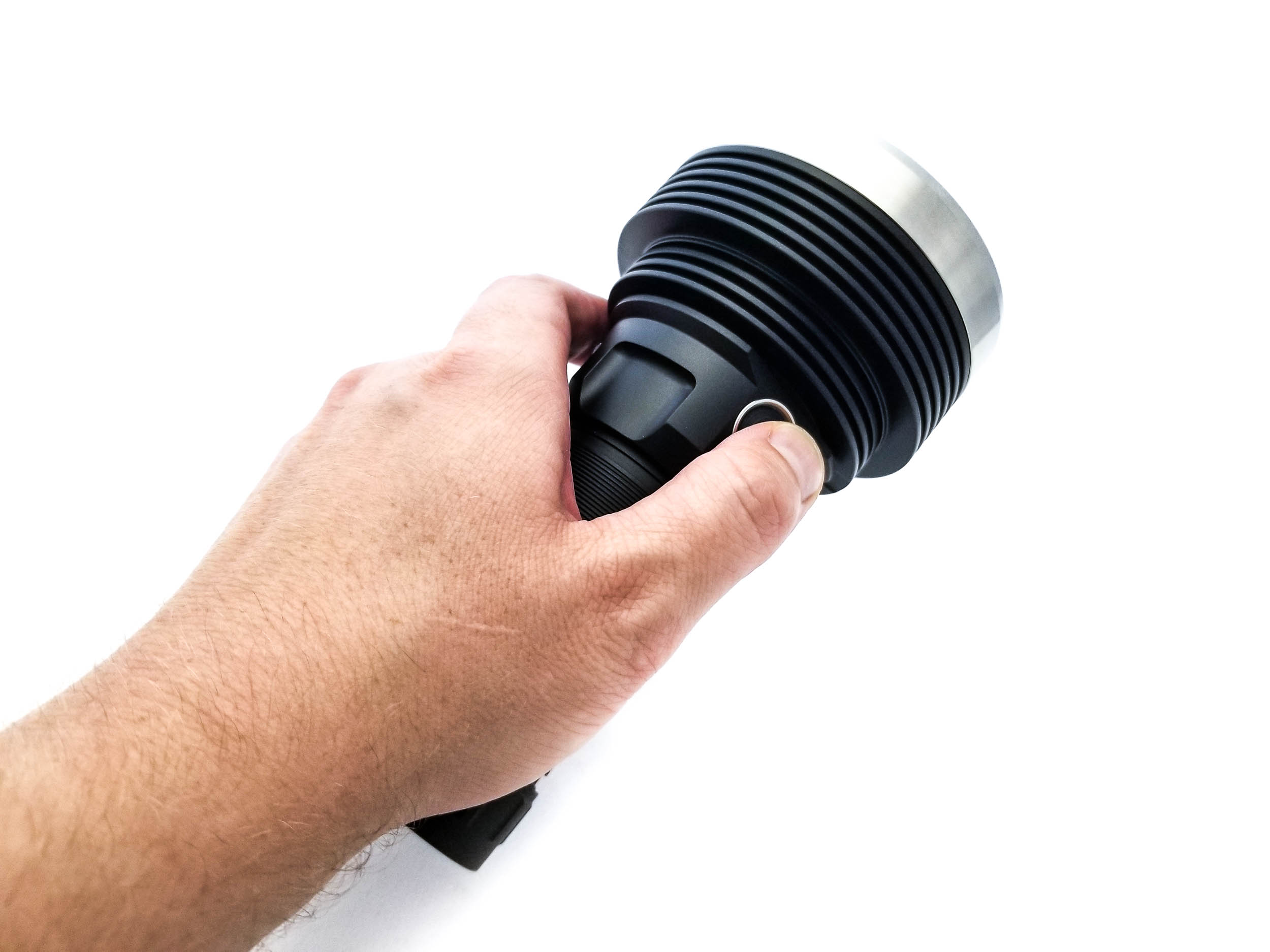
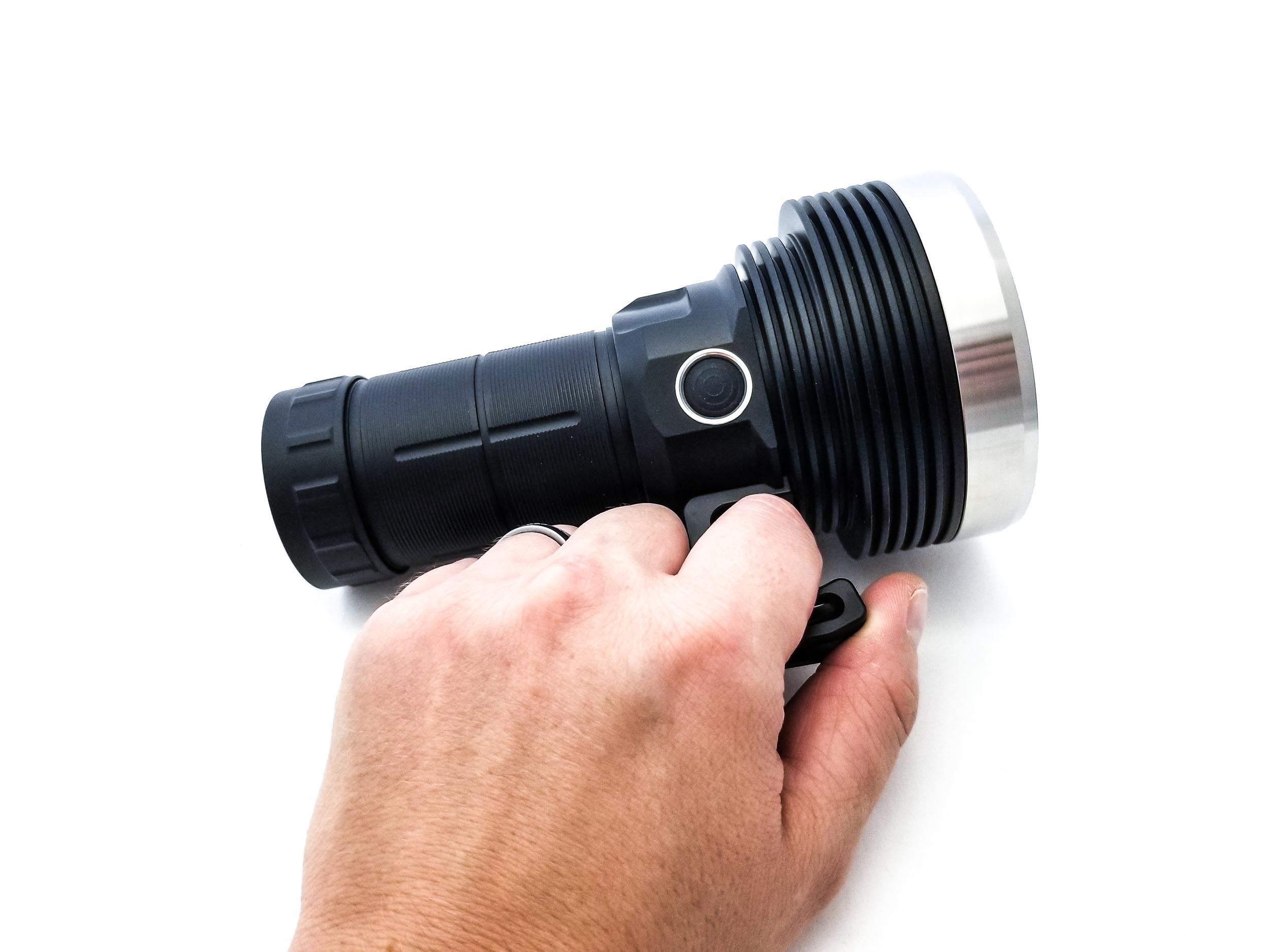
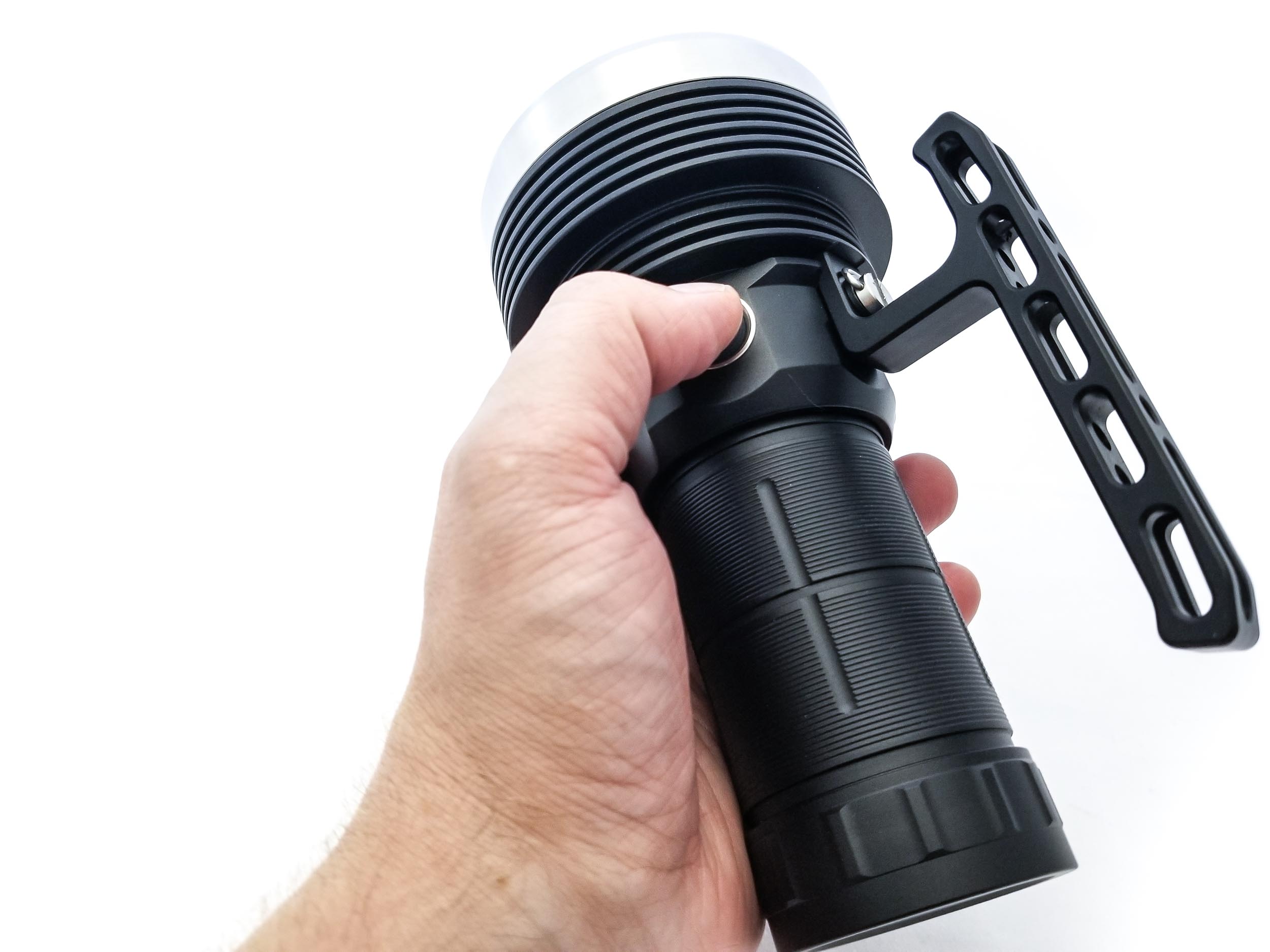
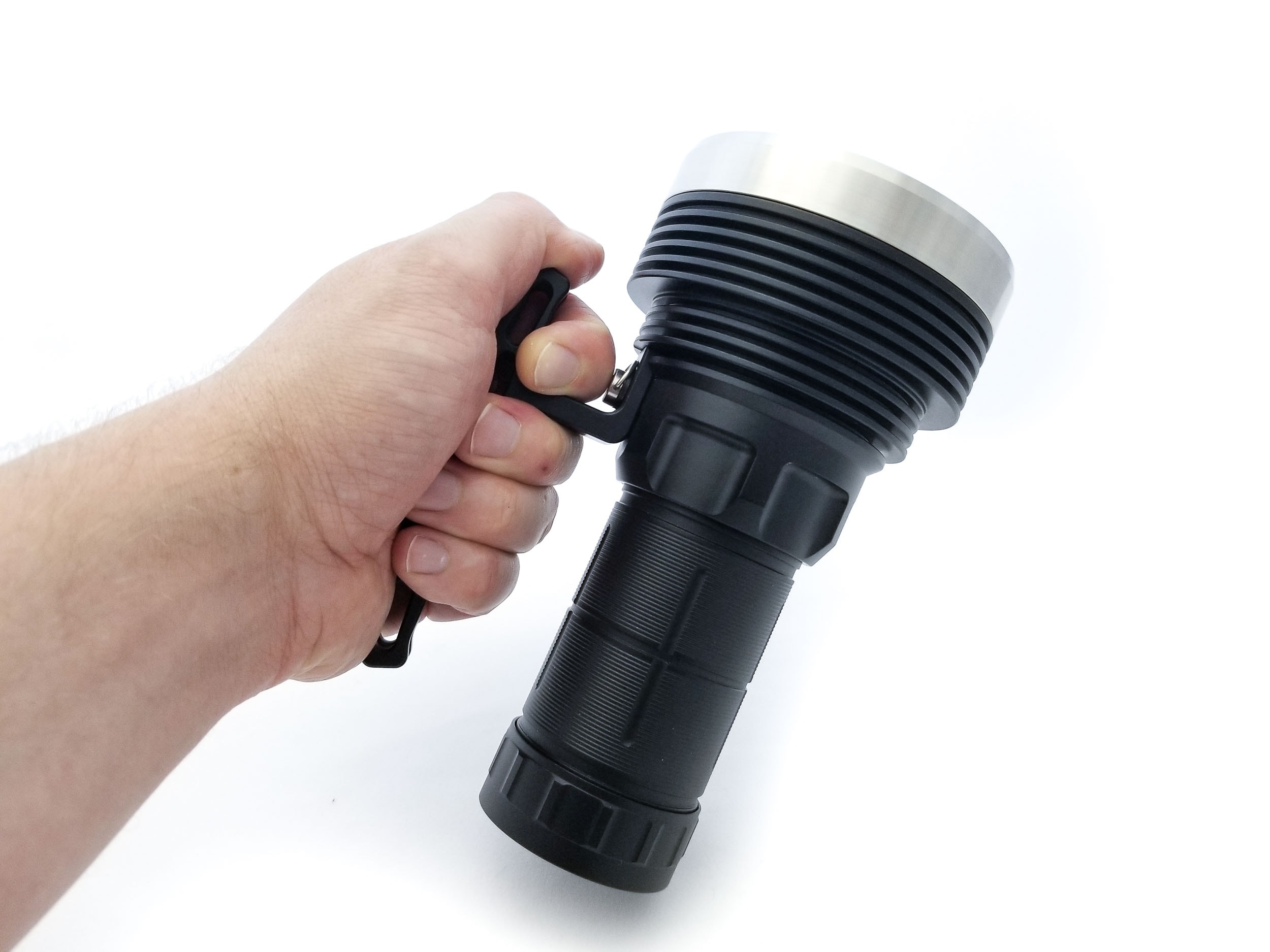
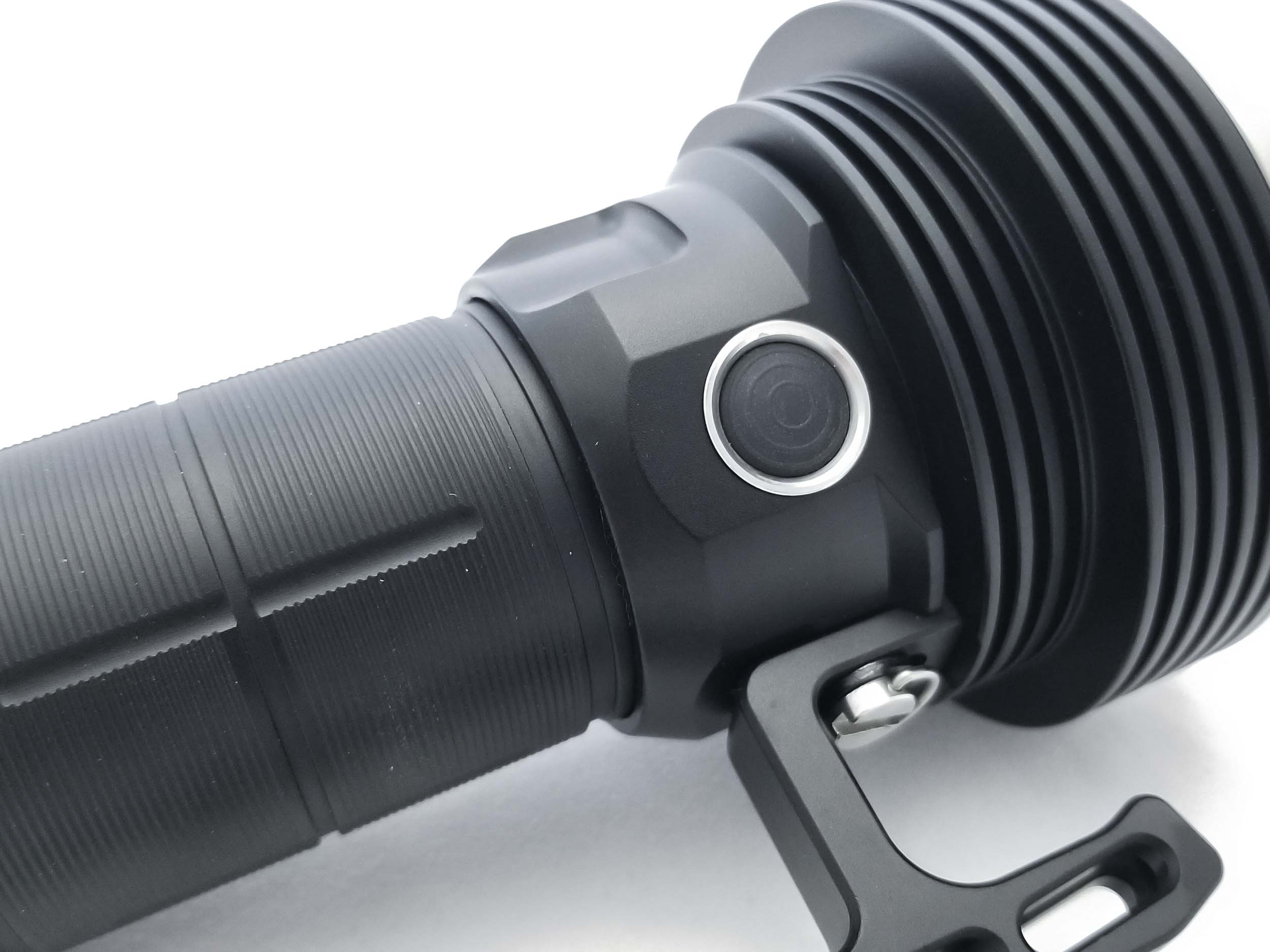
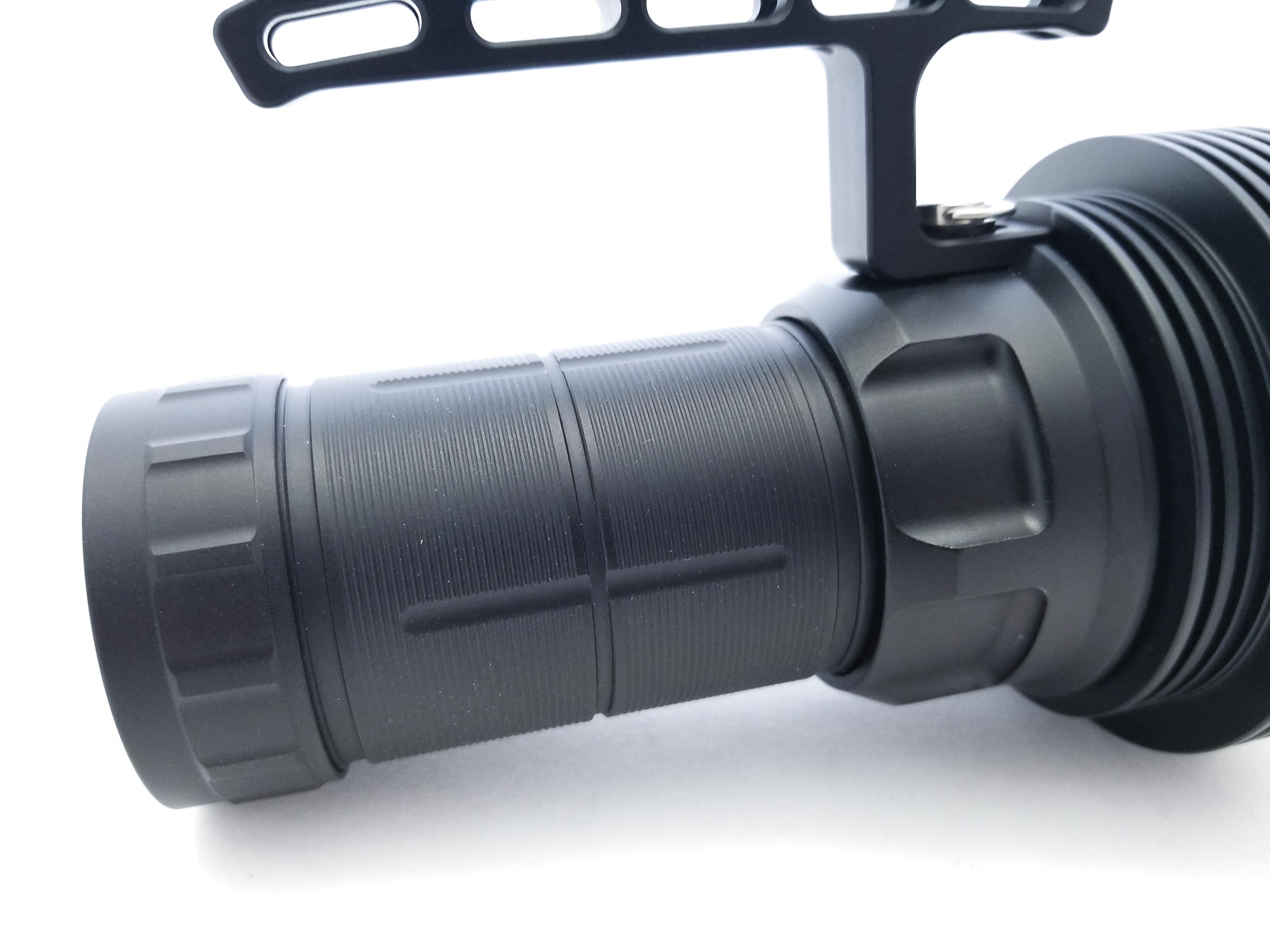
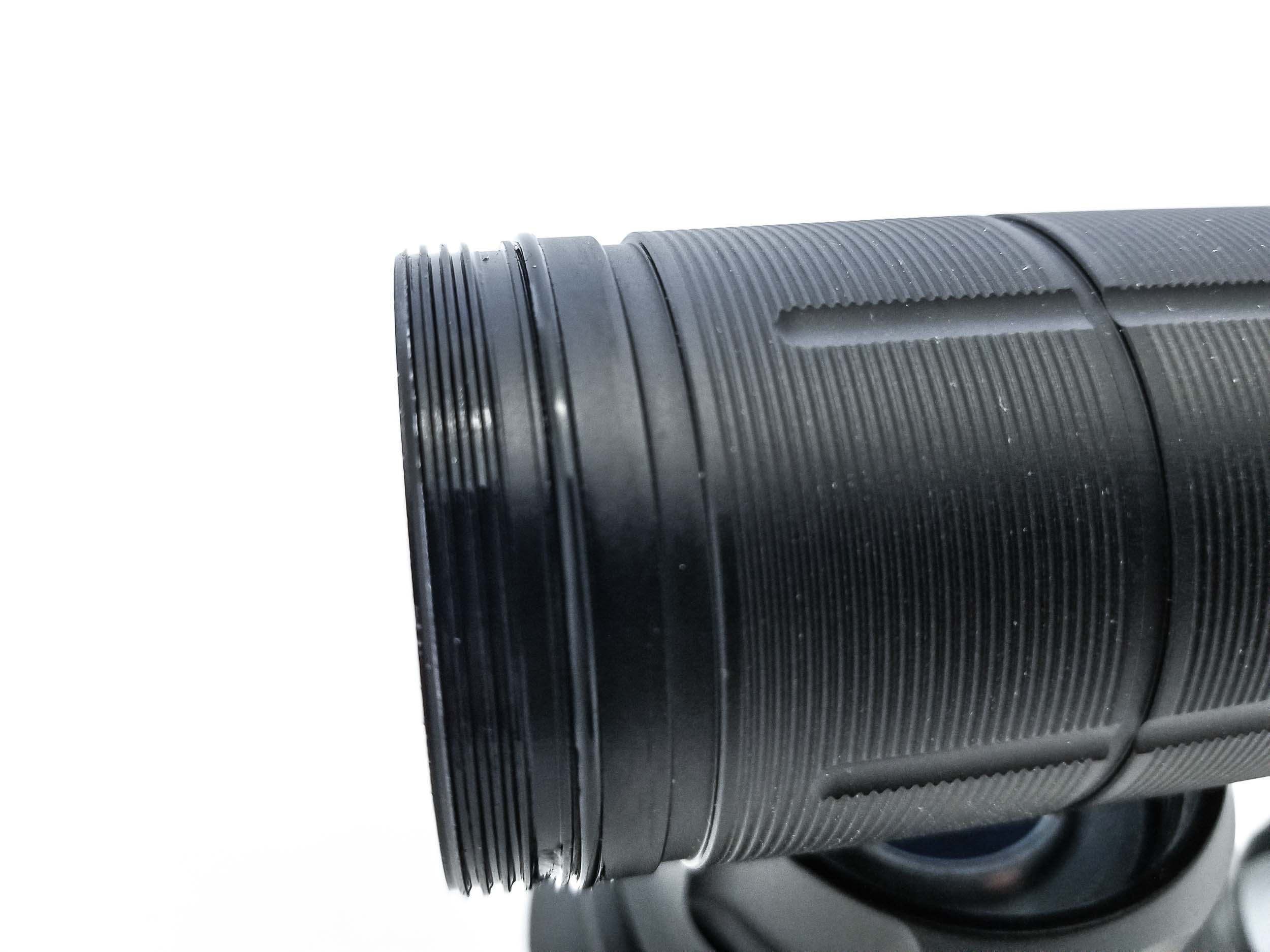
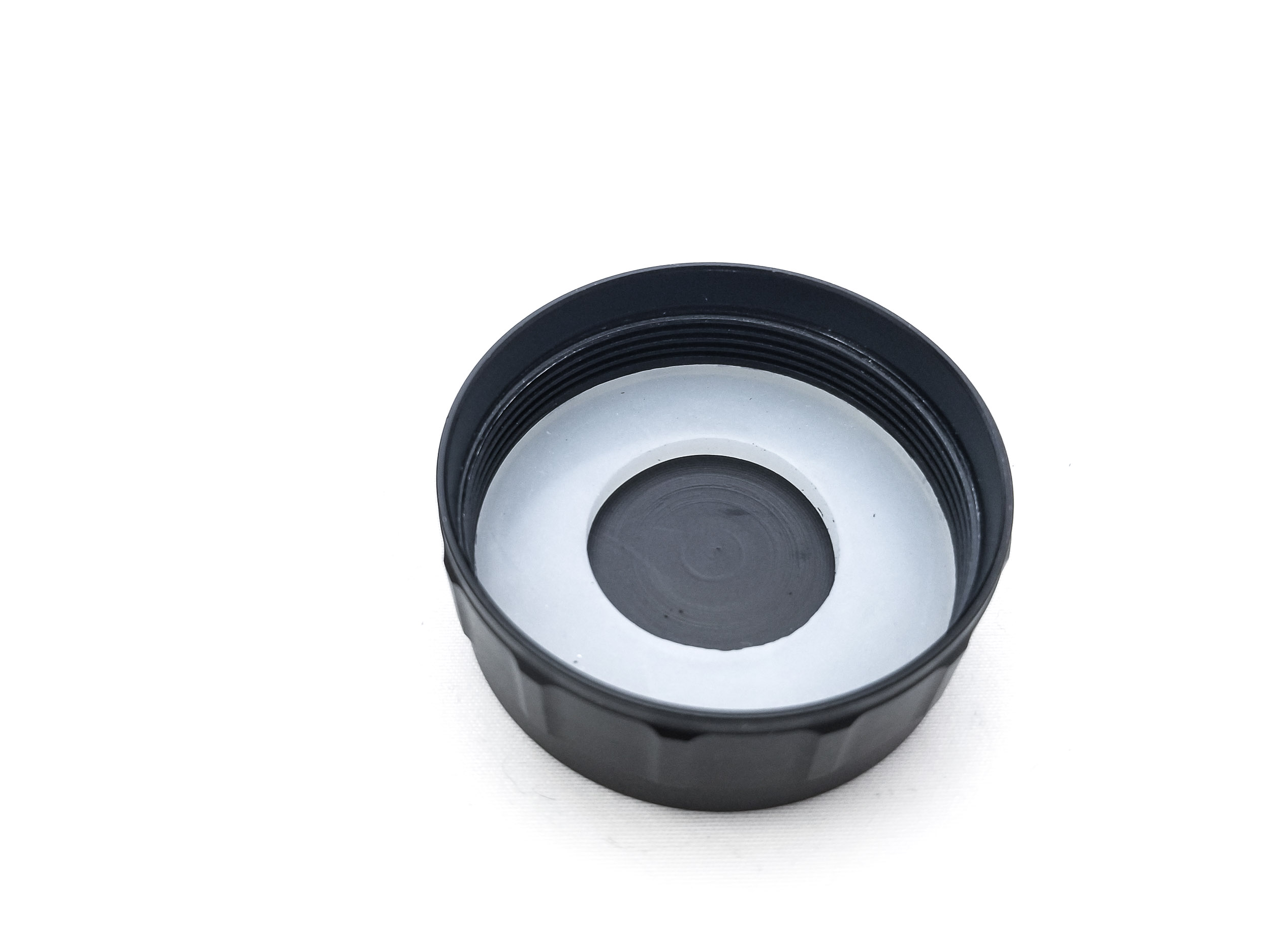
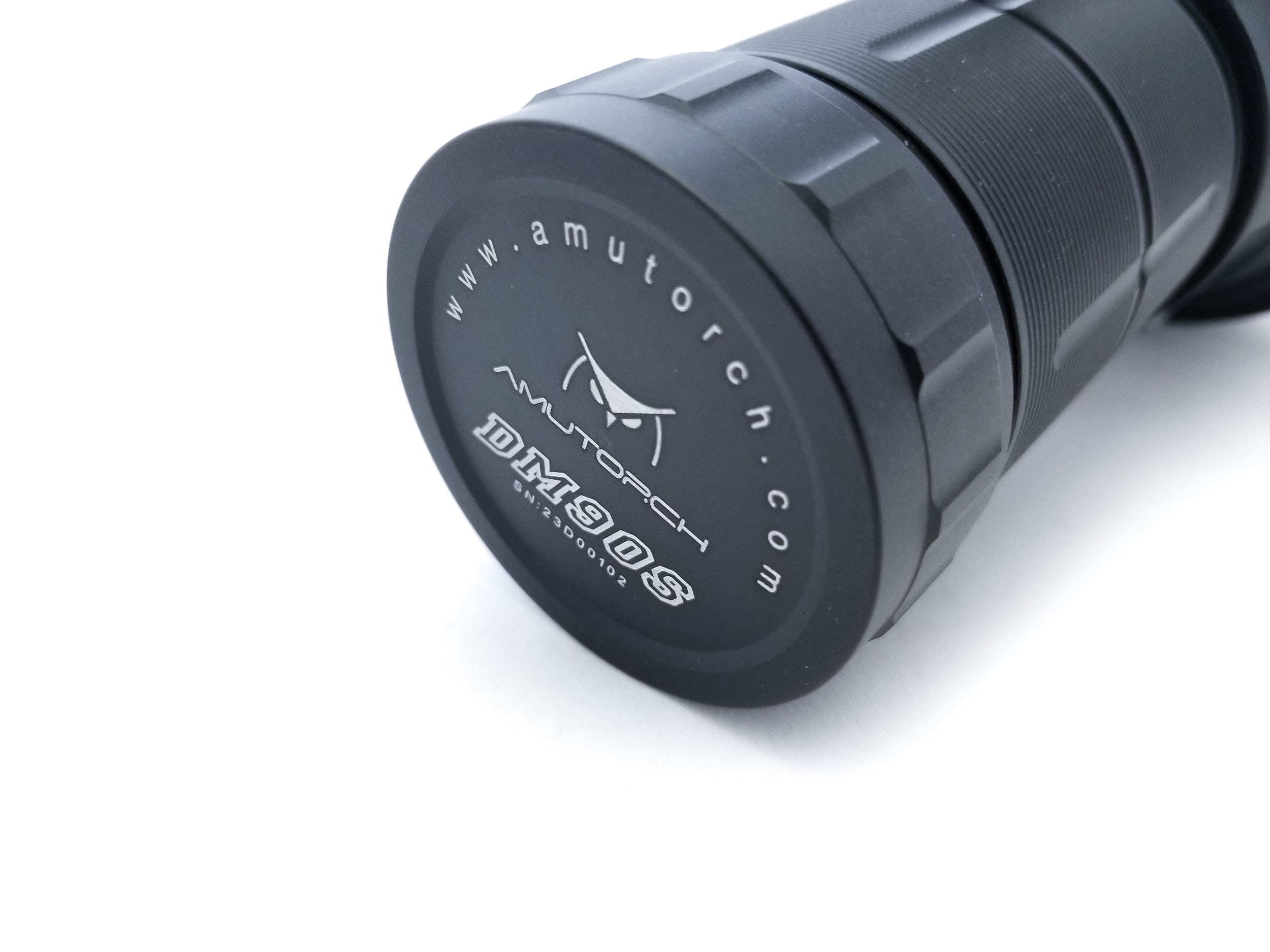
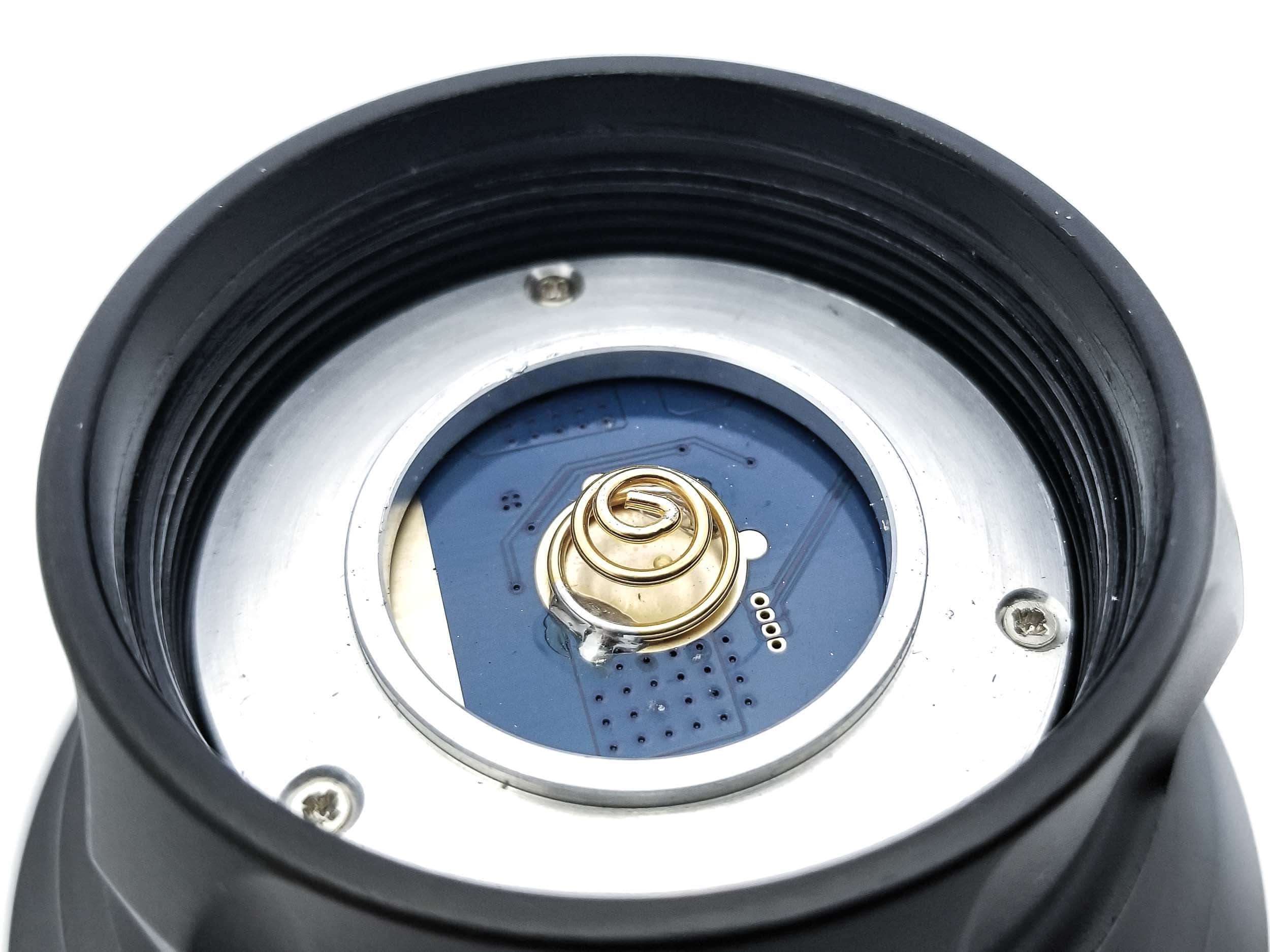
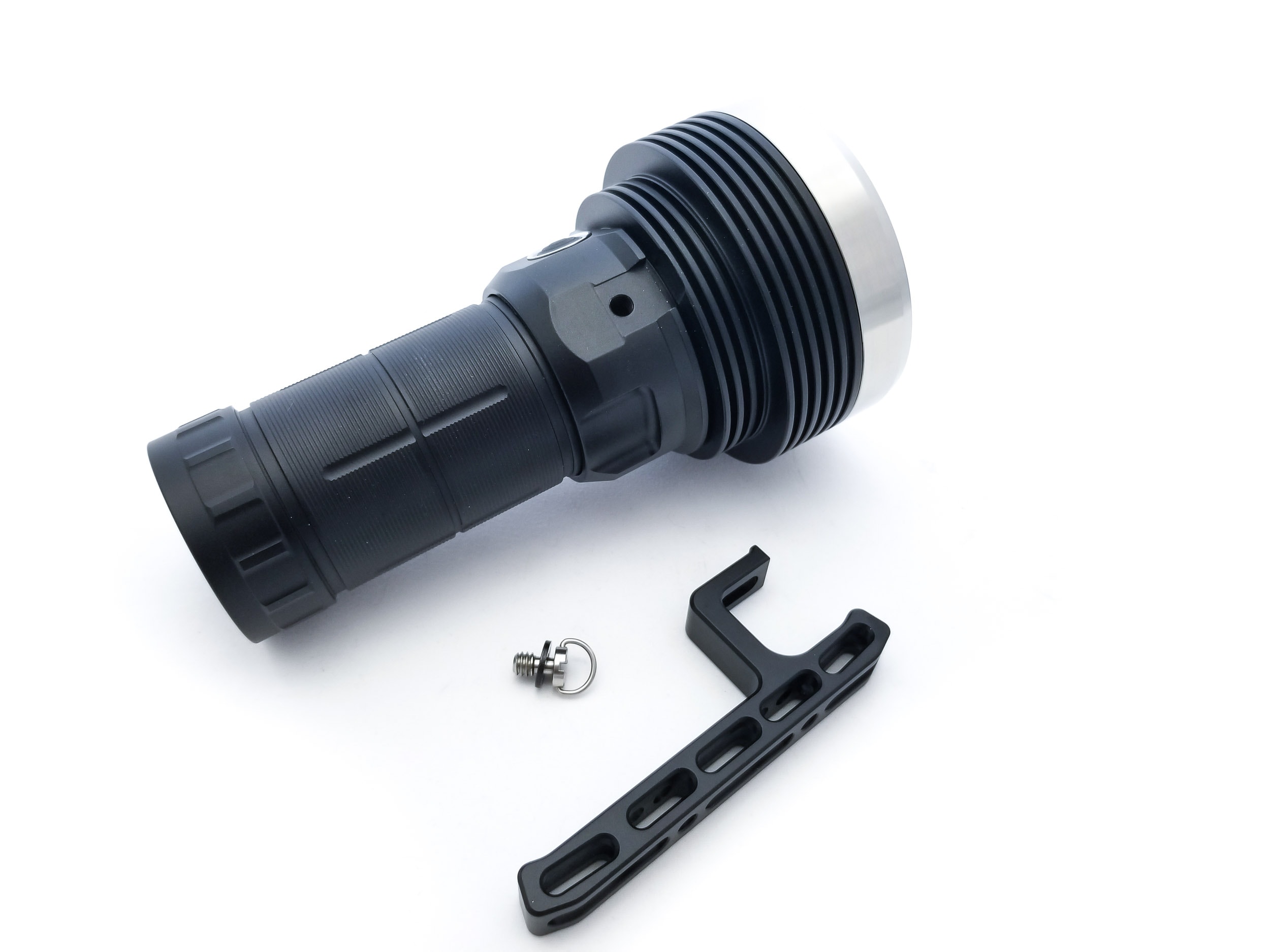
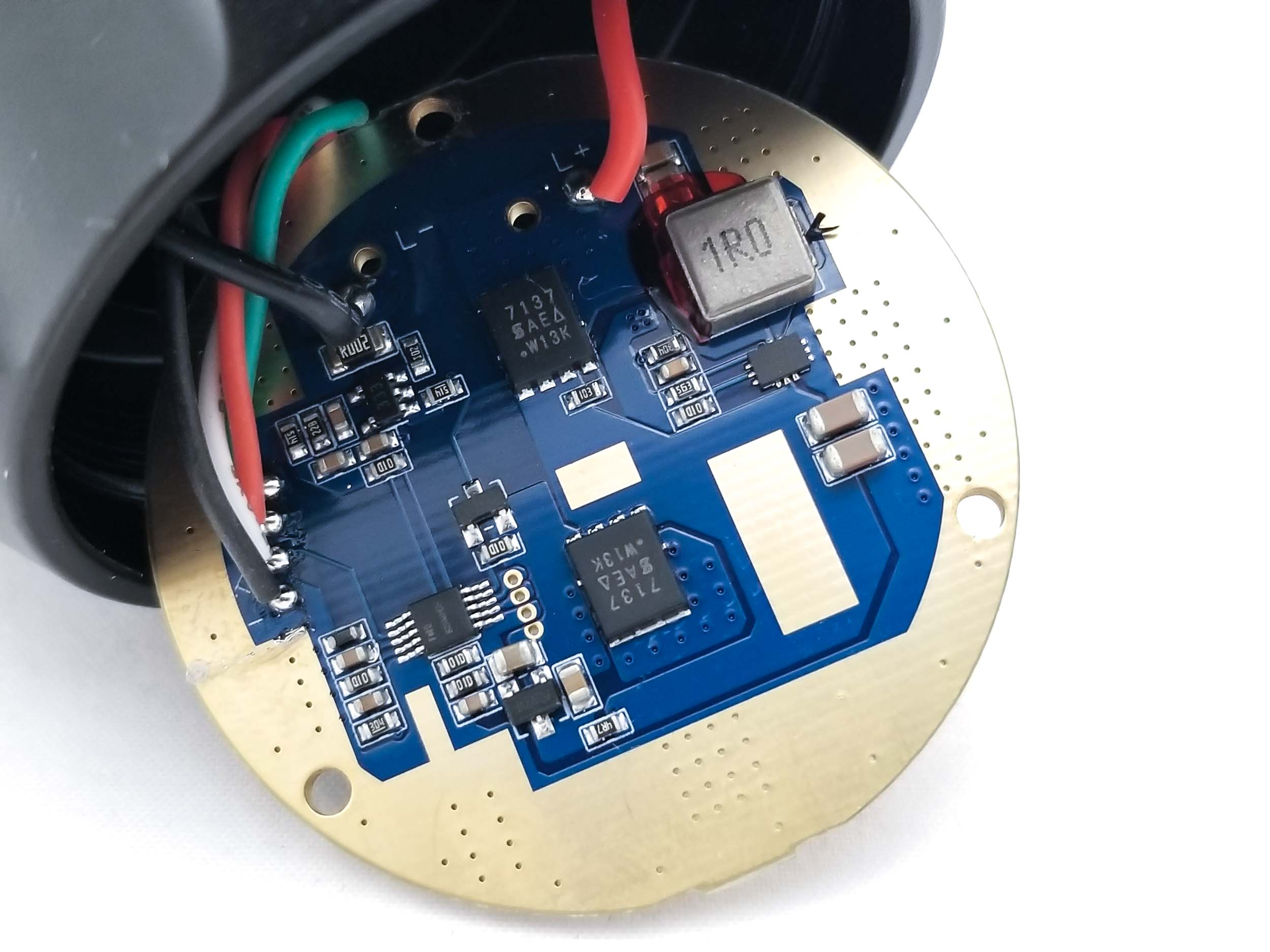
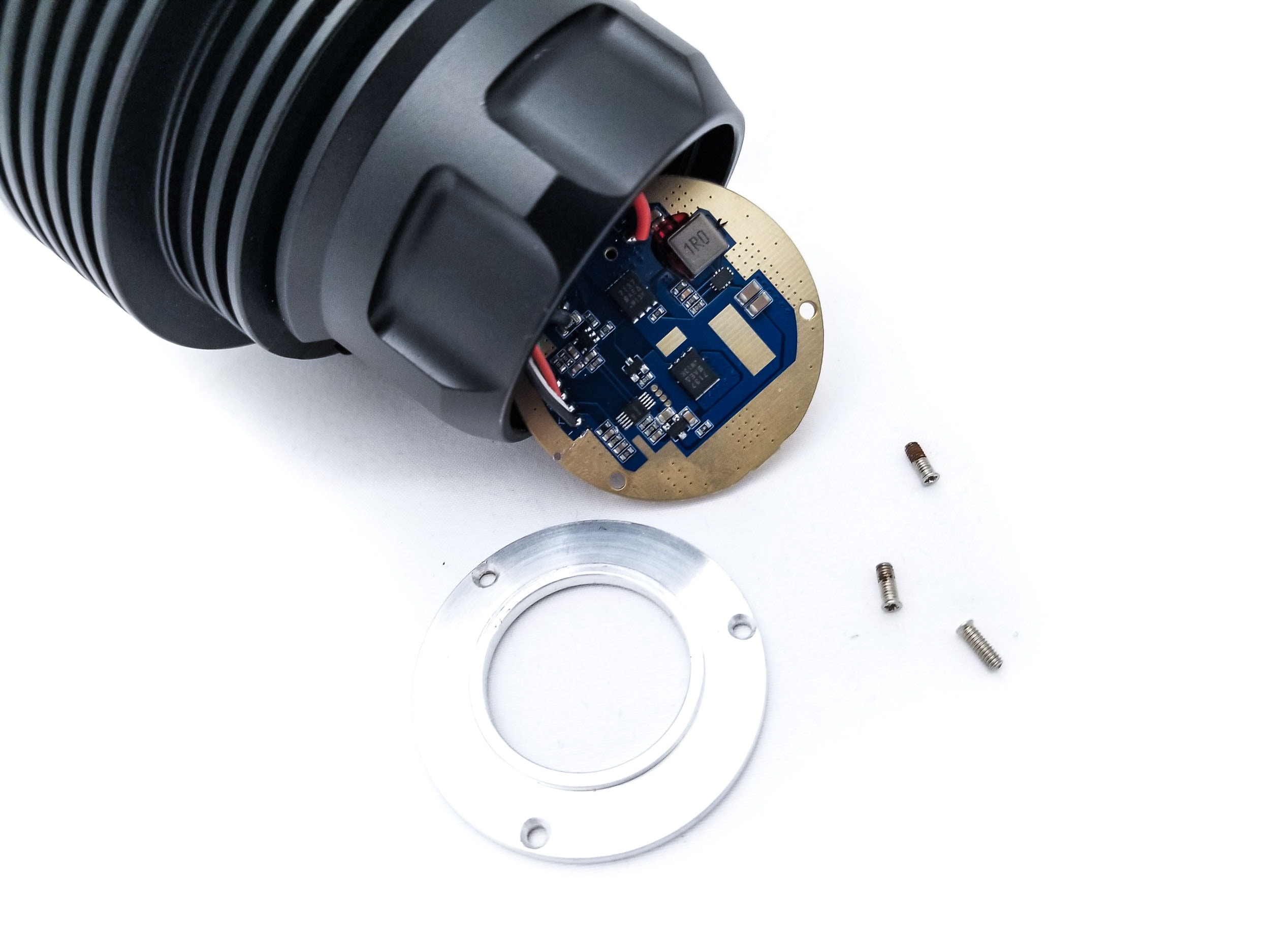
LED, Lens, Bezel, Beam, and Reflector
Here’s where it gets a bit quirky. The DM90S comes in two LED flavors, one with the Luminus SBT90.2, which we all know and love, and the other option is the RC90 LED. Peeking down into the reflector, this LED bears a striking resemblance to the Luminus SBT-70, but I suspect this is a Chinese clone. The SBT-70 was a revolutionary LED back in the day (think 2013 vintage) that had good specs, came in a neutral white tint along with red, green, and blue wavelengths, but poor efficiency and was really expensive ($50 per LED), so it never gained any footing in the flashlight industry, with only Olight (the SR95S-UT) and Nitecore (the TM36) producing lights with this LED.
The RC90 is a 3 volt LED using the same 10mm x 11mm footprint as the SBTxx, and has a round LES and bond wire construction. It even has the AR coated glass window over the LES like the SBT-70. The round LES gives about 7mm2 of emitting area, so less than the SBT90.2 (9mm2) for perhaps a bit more luminance?
The bezel is stainless steel on my test light, and looks good! The reflector is a deep SMO unit with the LED sitting at the bottom in a red centering ring. Okay the beam. Well, it’s not clean and has bright rings that are clearly visible everywhere. There’s a bright tight hotspot and lots of bright spill, typical thrower beam stuff.
The CCT of this LED looks a bit warmer than most Chinese LEDs that I’ve encountered, and the Opple Lightmaster Pro agrees!
At 5 meters from the sensor on High, the temperature is coming in at 4465K and CRI Ra 66.4. The duv is 0.0062 and while not Nichia 519A quality, it’s nonetheless a nice departure from the waayyy cool white Chinese clone LEDs out there.
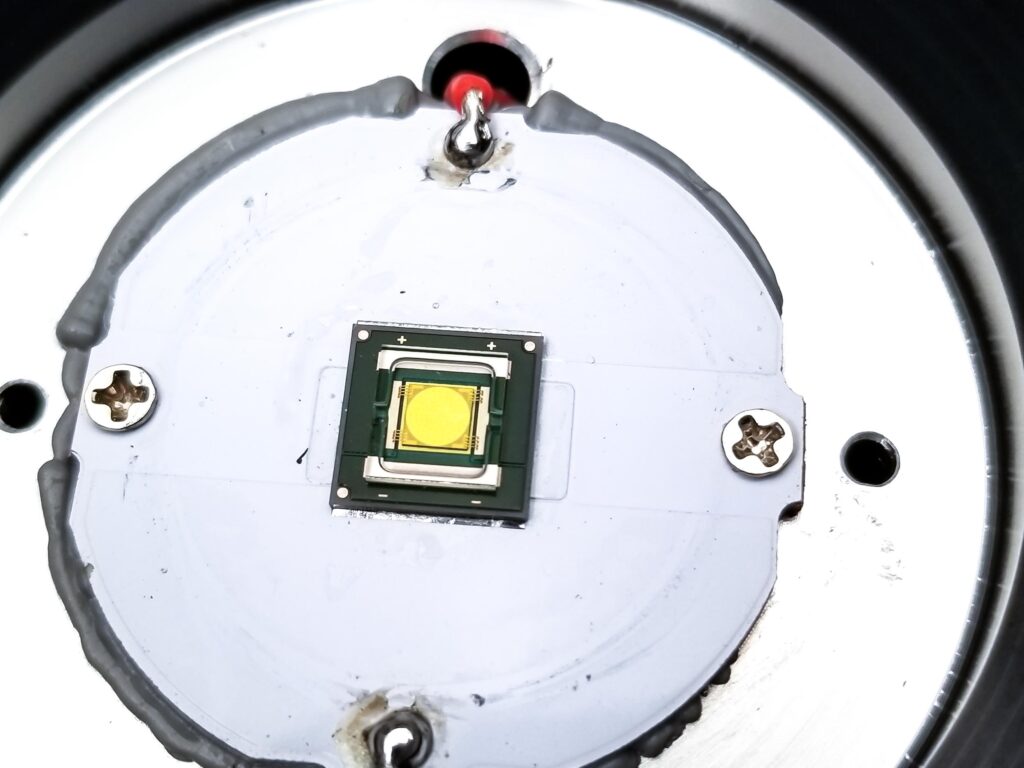


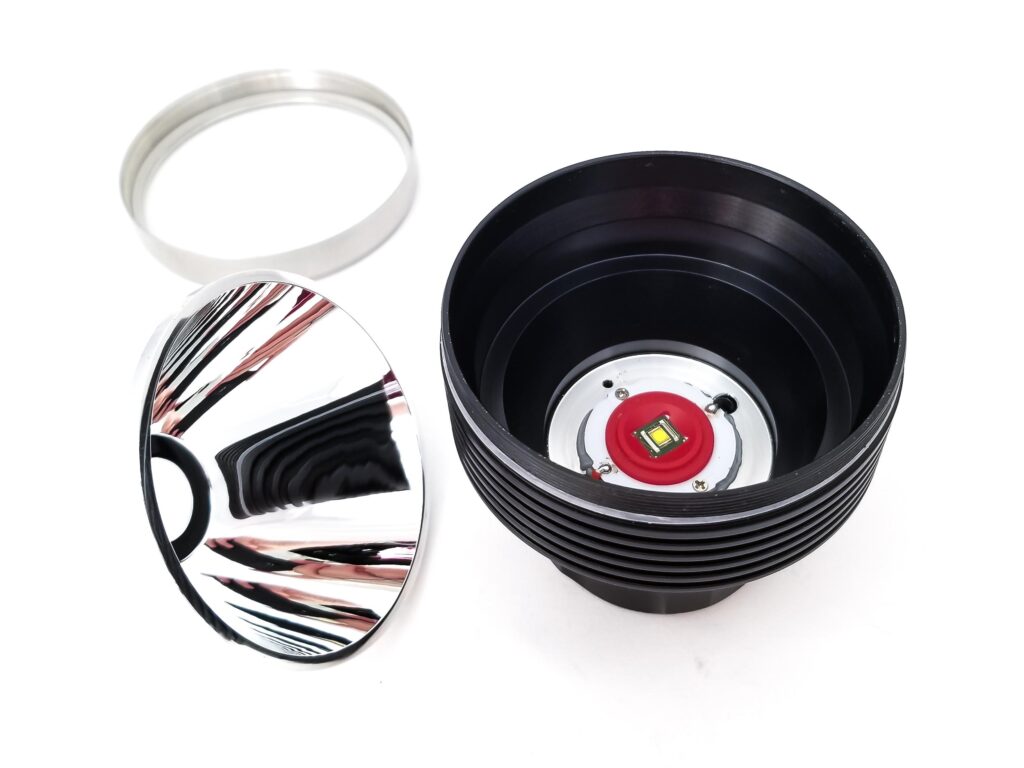

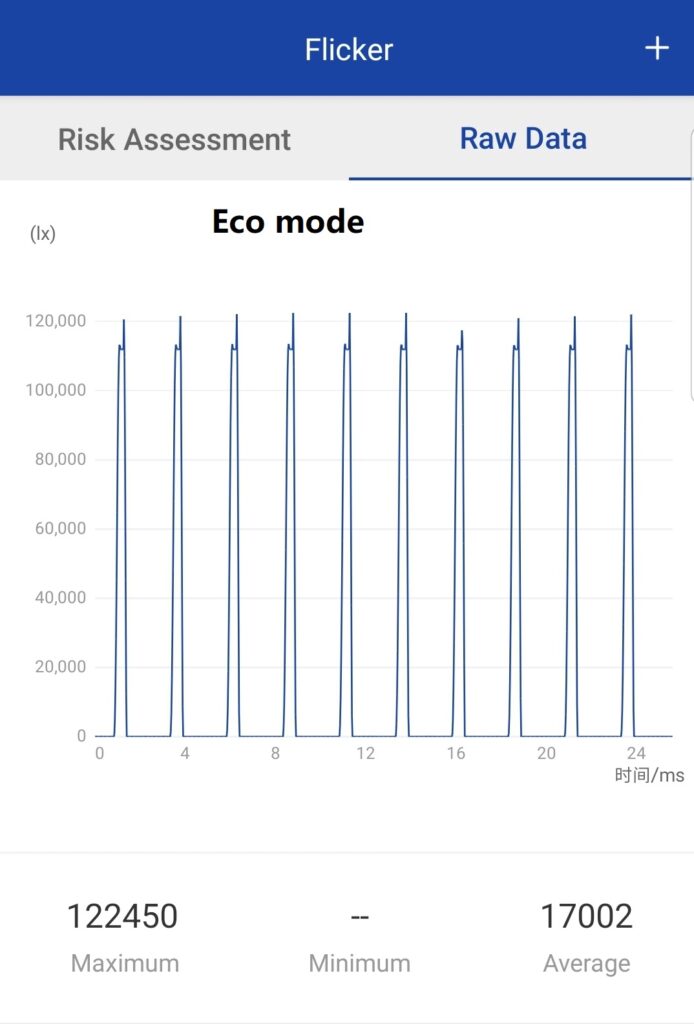
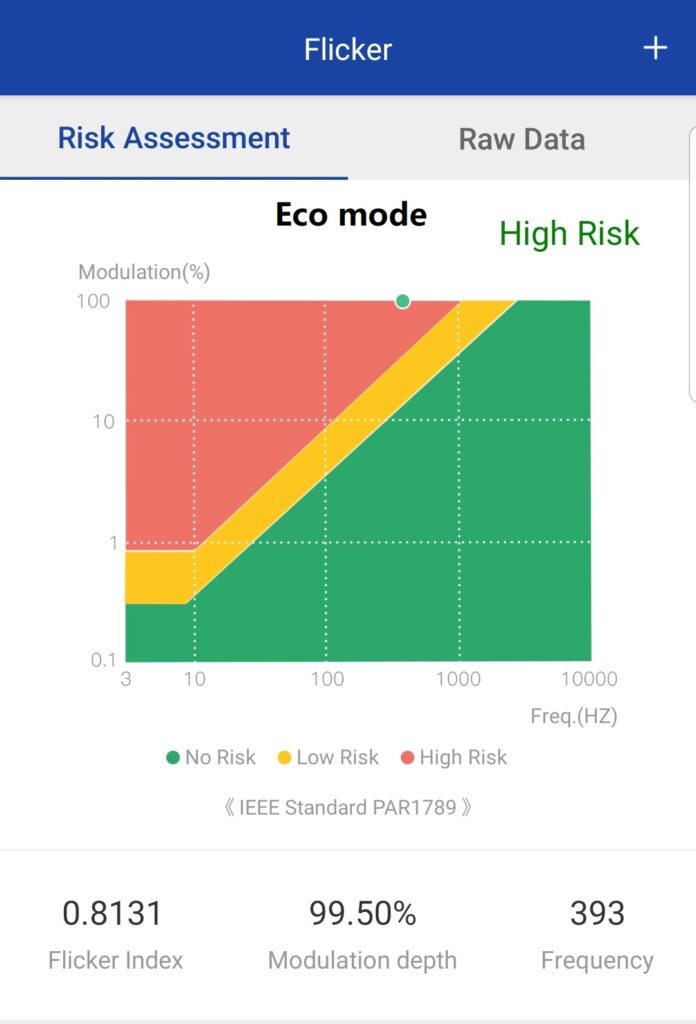
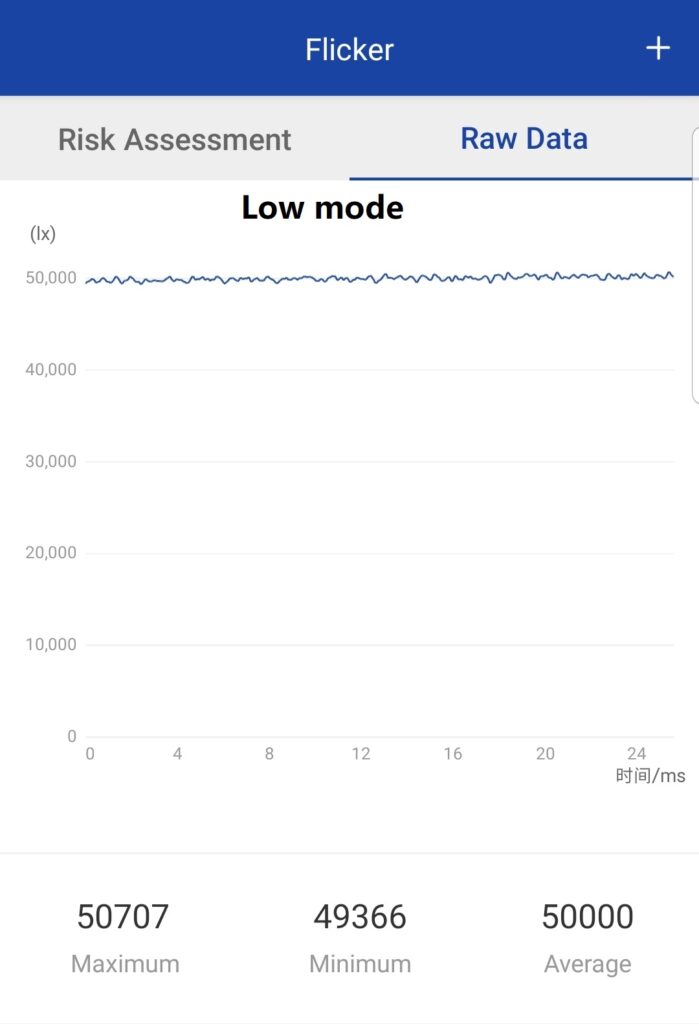
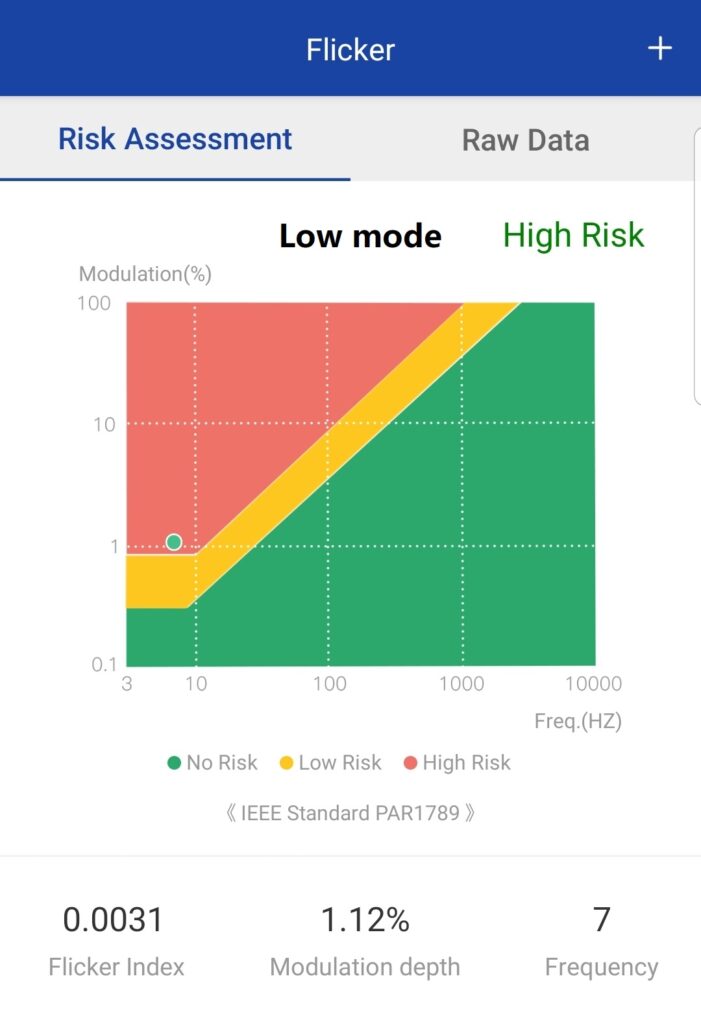
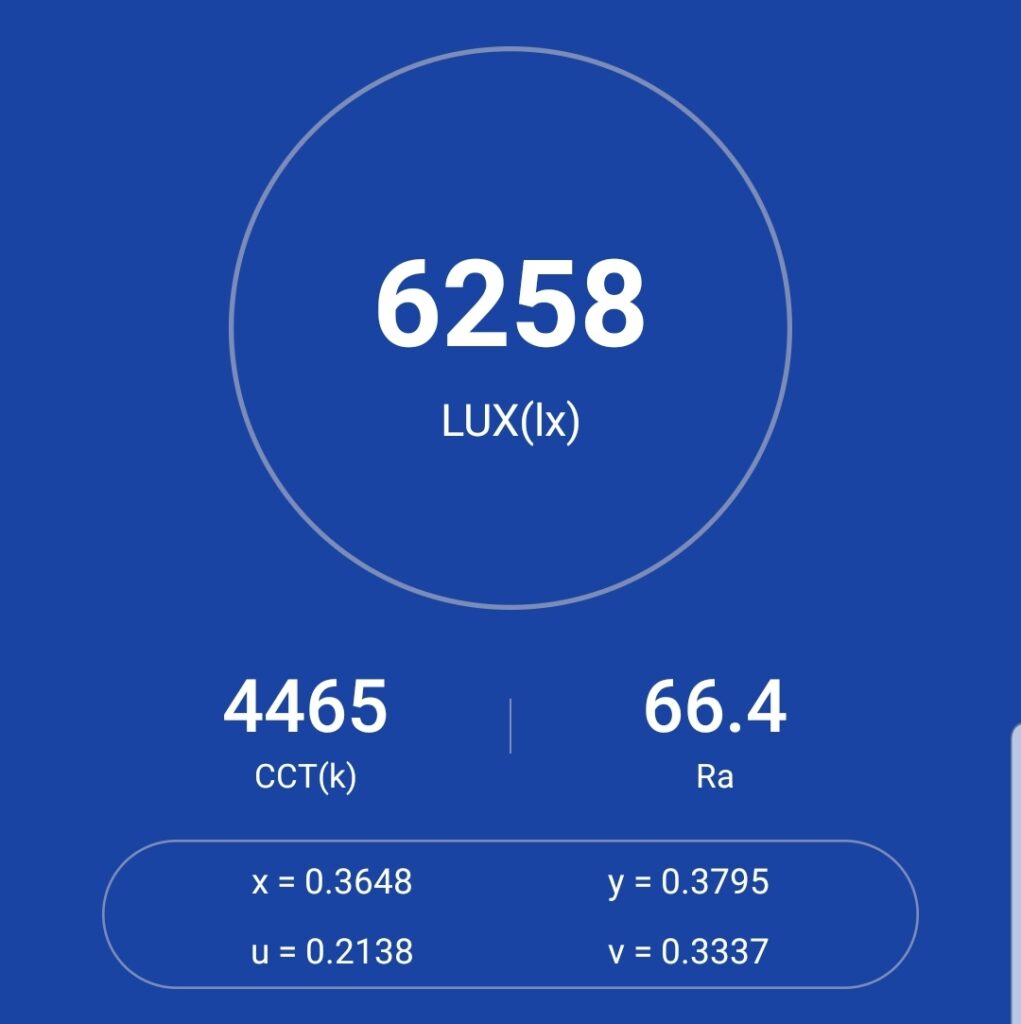
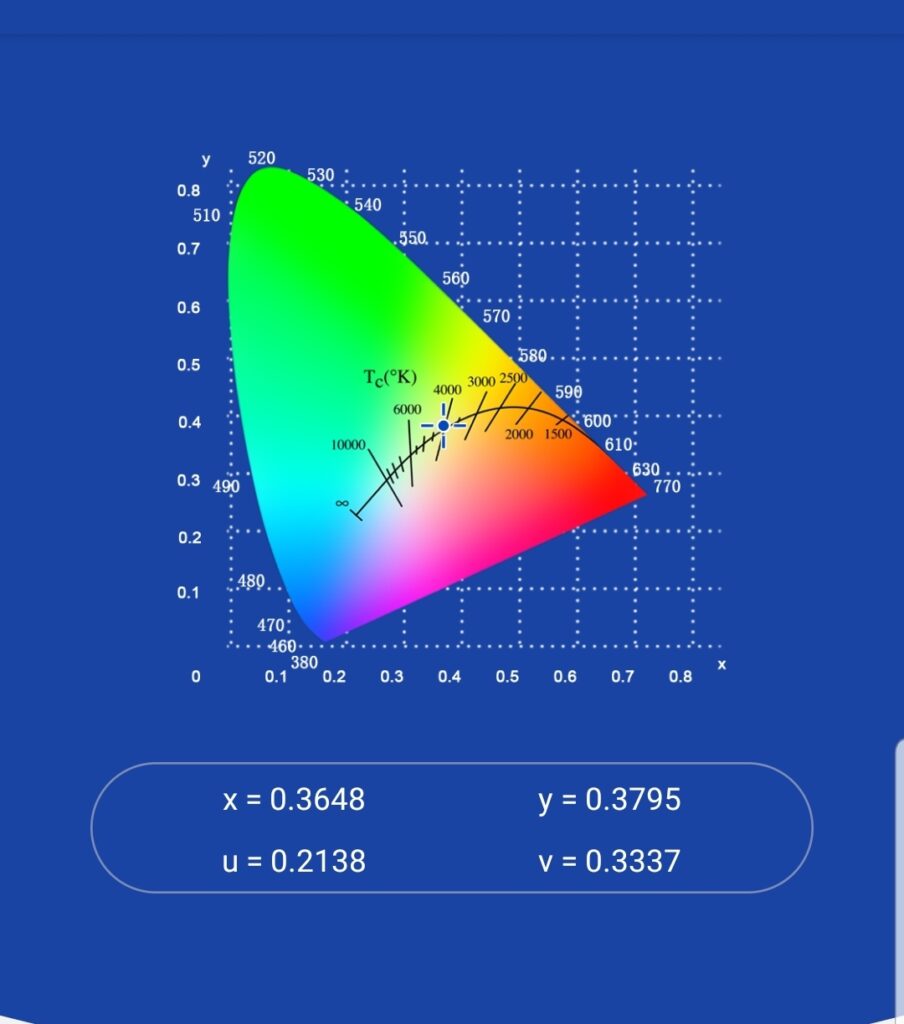
Dimensions and its competition
Dimensions:
| Amutorch DM90S | Millimeters | Inches |
|---|---|---|
| Length | 175 mm | 6 in |
| Head diameter | 93 mm | 1.3 in |
| Body | 51 mm | 1 in |
Dimensions are rounded to the nearest millimeter, and to the nearest tenth of an Inch.
Weight:
| Amutorch DM90S | Weight in grams | Weight in oz |
|---|---|---|
| With 46950 battery (and handle): | 992 g | 35 oz |
| Without battery: | 572 g | 20 oz |
Weight is rounded to the nearest gram, and to the nearest tenth of an oz.
That battery is massive and heavy! Just the battery weighs in at 432 grams, which is more than five 21700 cells! I weighed the cell carrier from the DM90, and loaded with Molicel P42As, it weighed just 235 grams. That added weight doesn’t hurt the handling of the light at all though despite being a bit heavy for this class.
Flashlight size comparison with its competition:
Group 1 left to right: Amutorch DM90, Amutorch DM90S, Amutorch DM80
Group 2 left to right: Haikelite HK90, Amutorch DM90S, Haikelite HT90
Group 3 left to right: Amutorch DM90S, WildTrail WT90
Group 4 reflectors left to right: Amutorch DM90S, WildTrail WT90
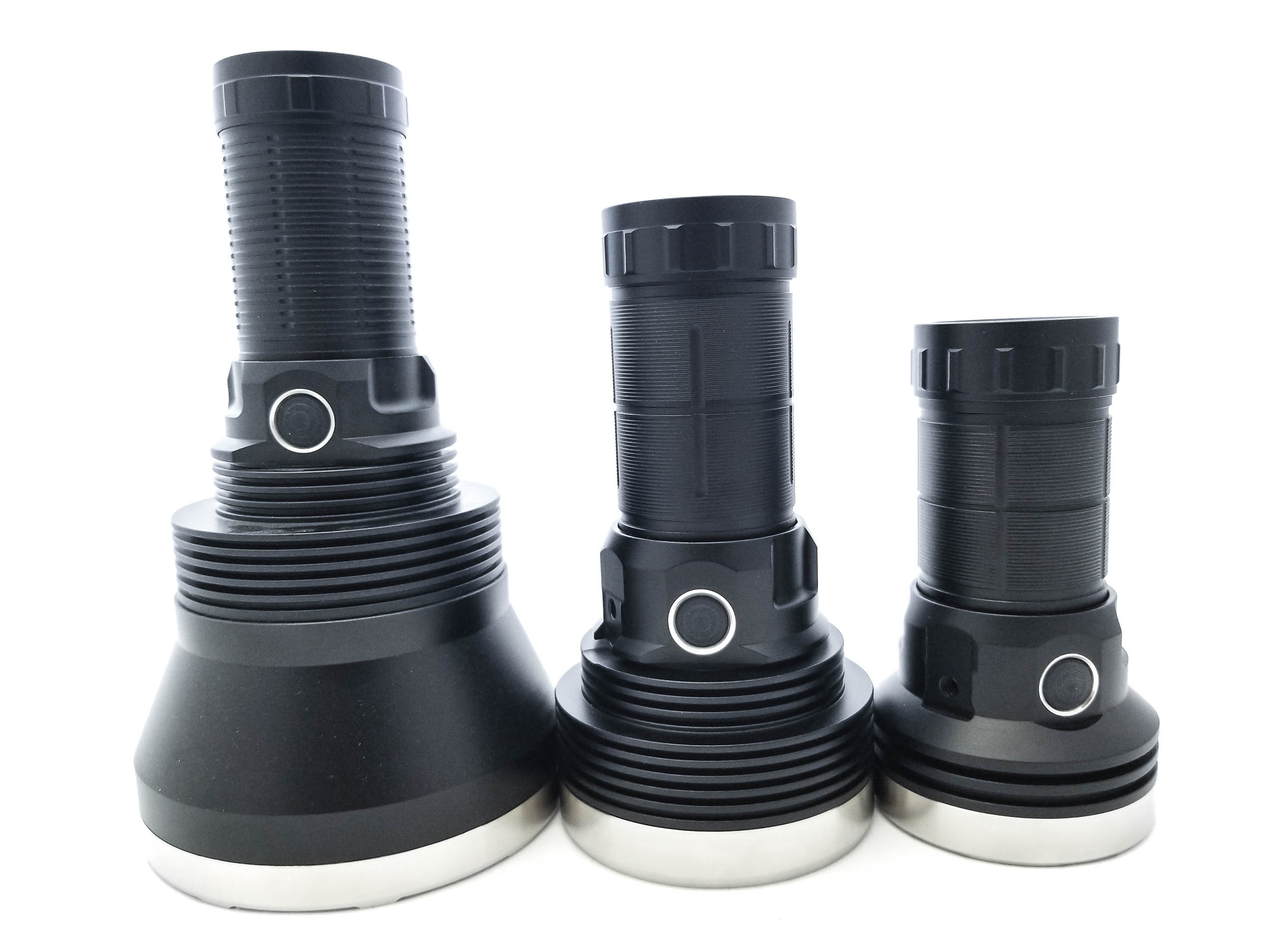
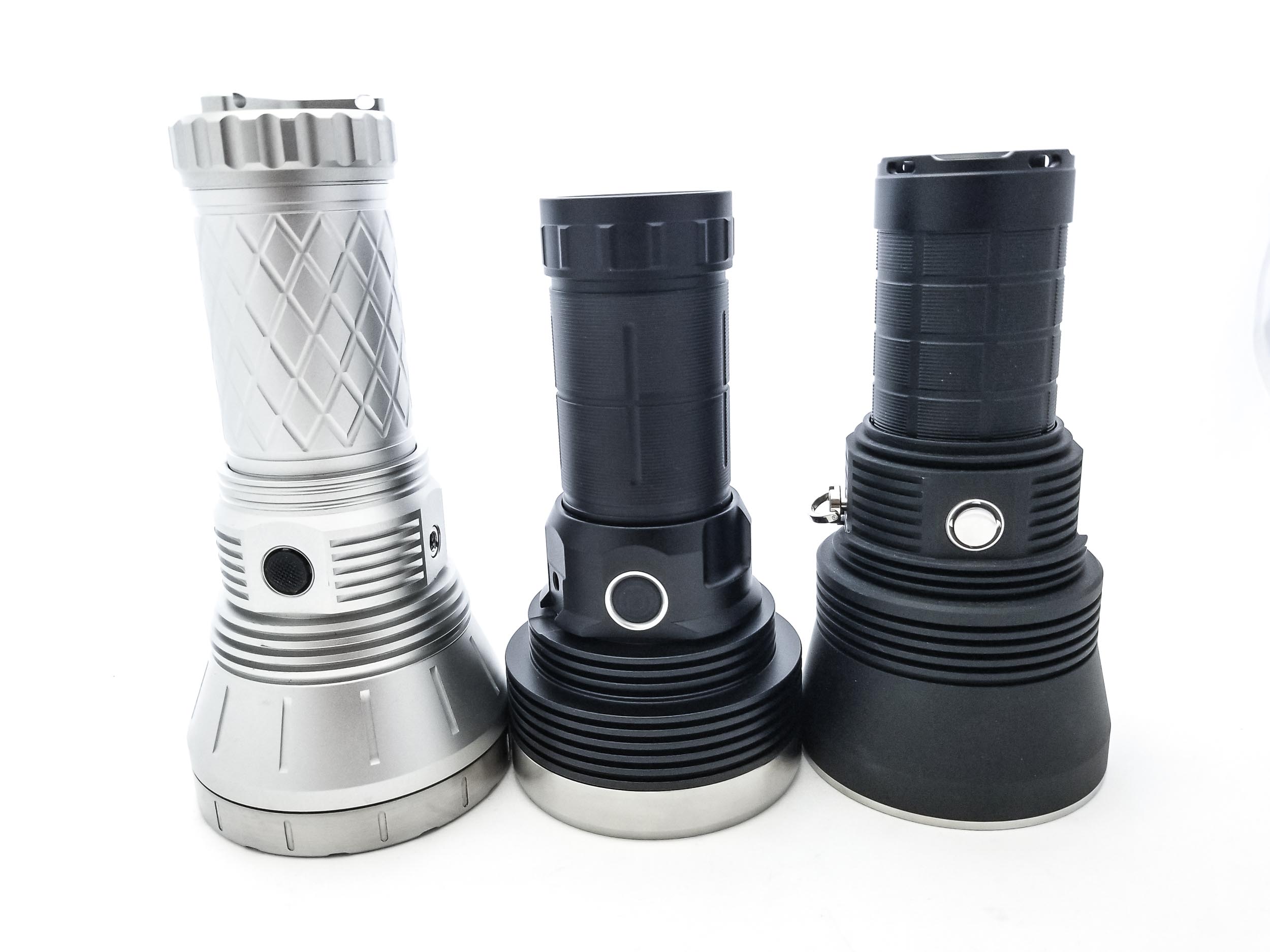
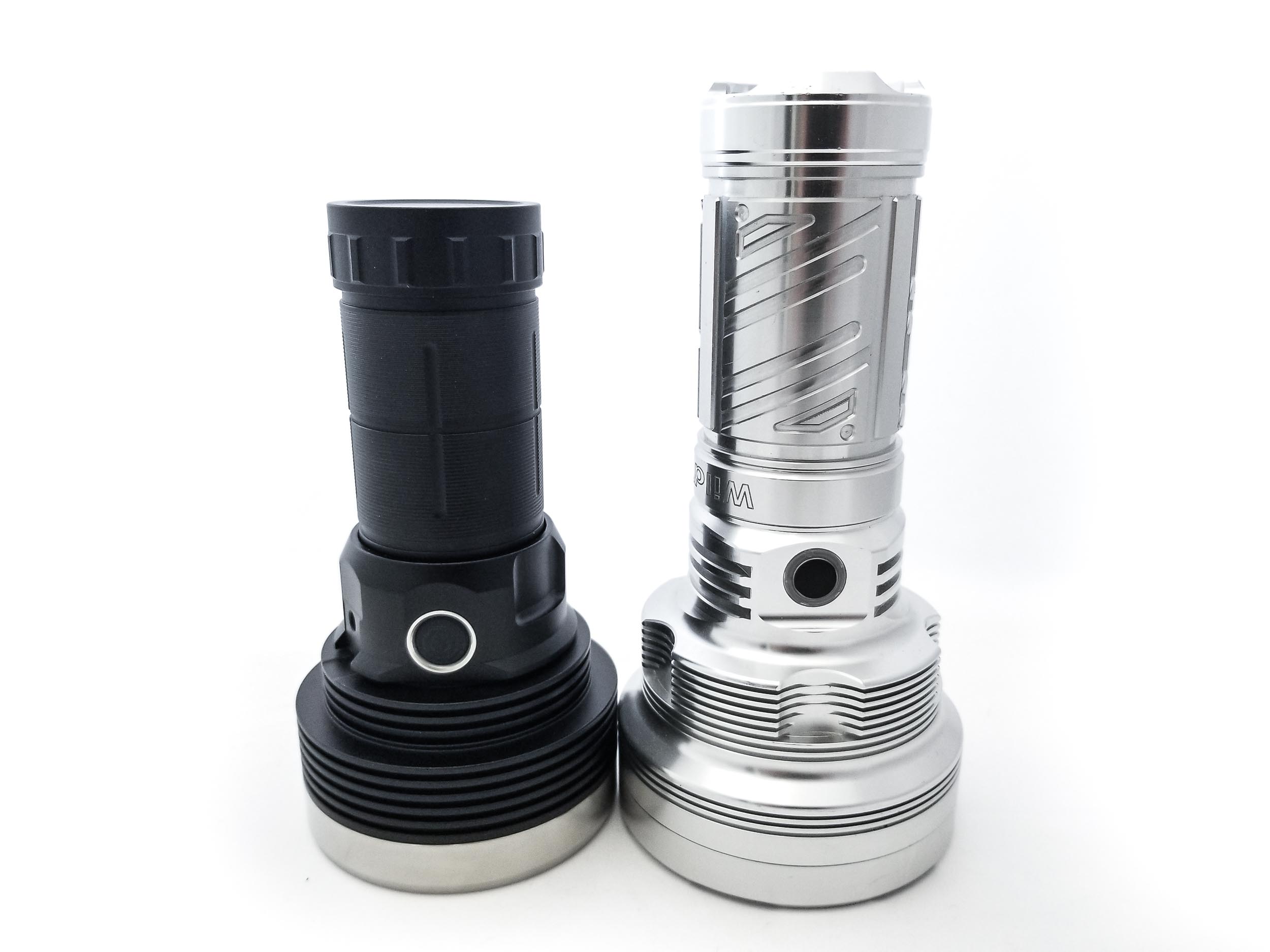
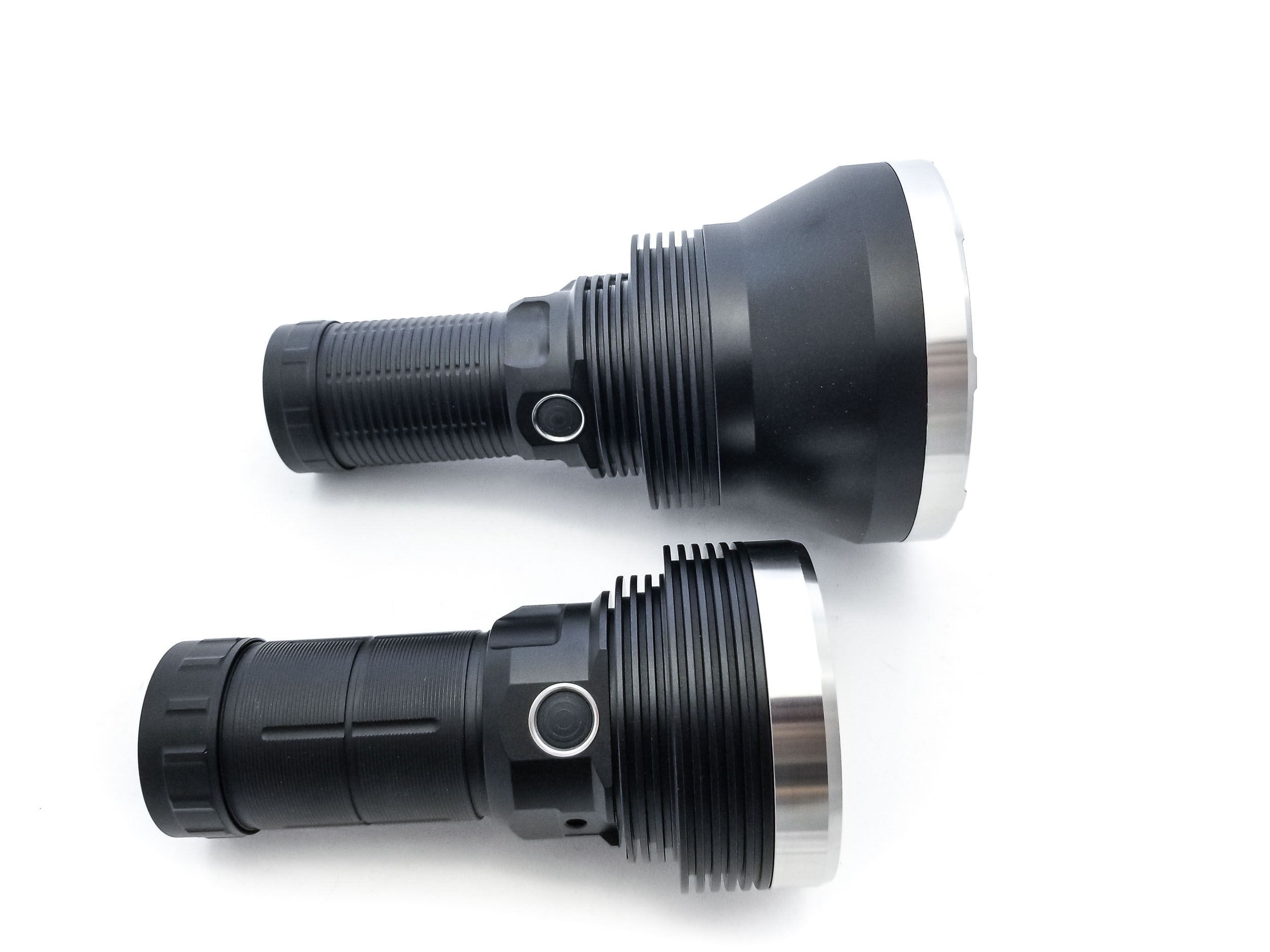
Amutorch DM90S UI: User Interface and Driver
The driver is going to remain a mystery until the runtime tests, but the other 3 volt DM series lights used buck drivers because they ran off series batteries (3S). I took a peak at it, and it has a small inductor, so this could very well be a buck driver or a linear, direct driver. The driver won’t have to buck the voltage too low though since this is a 1S configuration.
The UI is a simple one click off, one click on, 3 mode, 2 clicks for Turbo, and a single Strobe. It’s nearly identical to the DM90, incorporating the smooth and stepped ramping features.
Available modes: Low, Mid, High, Turbo
Available blinky modes: Strobe
User interface:
From OFF:
- Single click: Turns on in Stepped Ramp Mode
- Click and hold: Turns on in Smooth Ramp Mode
- Double click: Turbo
- Triple click: Strobe
From ON:
- Single click In Smooth Ramp Mode: Turns off
- Single click In Stepped Ramp Mode: Changes modes L-M-H
- Click and hold in Stepped Ramp Mode: Ramps brightness up. Releasing and pressing and holding again ramps down.
- Double click: Turbo
- Triple click: Strobe
Mode memory
- Memorizes the last used mode for smooth/stepped ramping. Turbo and Strobe are not memorized.
Shortcuts:
- Double click for Turbo
Low voltage warning:
- Yes. The switch LEDs change color based on the battery state. Green is 100%-50%, orange 50% to 20%, and 20% and under the switch LED turns red. The manual says the light itself will indicate LVP.
Strobe/blinkies
- Strobe
Lock-out mode:
- Yes, electronic lockout accessed by 4 clicks from off. The light will blink in low mode and the switch LEDs blink red when the switch is pressed. Repeat to unlock. The switch LEDs will blink green and the light will blink in Low to acknowledge.
Shortcuts:
- To Turbo: Double click from on or off
- To Strobe: Triple click from on or off
PWM
- None
Additional info on the UI: Although slightly different from the DM90 UI and XT series UI, there’s a lot of continuity between them. The mode spacing isn’t terrible either. However, the smooth ramping quirks remain. From bottom to top of the ramp takes a whole 5.5 seconds. Anduril takes about 3.4 seconds, and it isn’t very linear. The ramp top and bottom are indicated by a slow double blink. Again, the smooth ramp and stepped ramp mode memories don’t commingle. It will start in whatever mode was last used when you used the smooth ramping, and the same is true for the stepped modes.
Starting in a stepped mode will default to the last-used stepped mode, and vice versa with the smooth ramping. I noticed there’s also a lower mode available if long-pressing from off, sort of like an eco mode, but not, and it has really bad PWM. The Low mode has no PWM. There’s ATR available here, and it works seamlessly after the first timed step down (+/- 10-15 sec.) in Turbo and High modes, and there’s visual LVP indicator blinks.
Amutorch DM90S Charging and batteries
The DM90S comes in two flavors, each with different battery configurations. This version of the DM90S is a special one battery-wise, and first off, major props to Amutorch for being the first manufacturer (not a modder and not one-off custom order shop) to make a light with this battery.
This light features the 46950 li-ion cell. It’s a 46 mm wide, 95 mm long massive monolithic cylindrical battery. This battery was released sometime in 2023 in China. I don’t know who made this one, but it’s branded Amutorch and has ‘32.000 mAh’ on the side. It’s electrically configured like a proprietary cell, with the positive and negative terminals on the top. Since there’s no room for a charging circuit, Amutorch developed an adapter for the 46950 cell. However, the review light didn’t come with it, and it was shipped later. While you could rig up some clips and wires and get your hobby charger to work, or if you had a Li-po charger with universal connections (like I did) you can make it work, but the cell charges painfully slow…like 1 amp or less. It took two and a half days to charge the cell from 3.6 volts.
Thankfully, Amutorch has an adapter. It’s a round device with two contact blades in the center and three magnetic contacts on the periphery (which also hold on the top housing). There’s a USB C input, and a clear spot for the indicator SMD LEDs. I finally received it after a month of waiting, and no instructions were included. It just fits over the top of the cell and is magnetically captured. Plug in a USB C cable and away you go. The indicator LEDs blink when charging and turn solid when finished. The charging speed varied, but was generally coming in at 8.8 volts 1.75 amps or 12.2 volts 1.54 amps depending on how you oriented the cable. The charge speed was capped at 20 watts. Decent, but I think this big cell needs at least 30 or 40 watts for charging. Even at 20 watts, it still took over 7 hours to charge from 3 volts. My capacity meter showed about 26 Ah. I got exactly two charges out of the adapter before it made a crackling/sizzling noise and the IC glowed orange, releasing the magic white smoke that makes electronics stop working. RIP charging adapter.
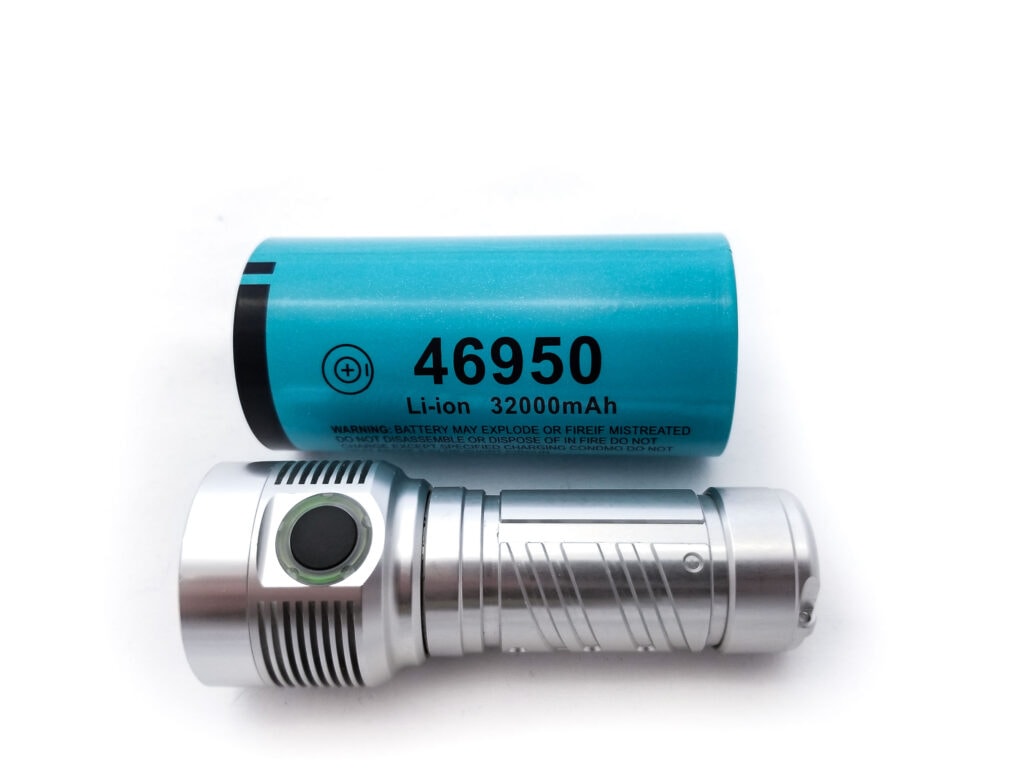
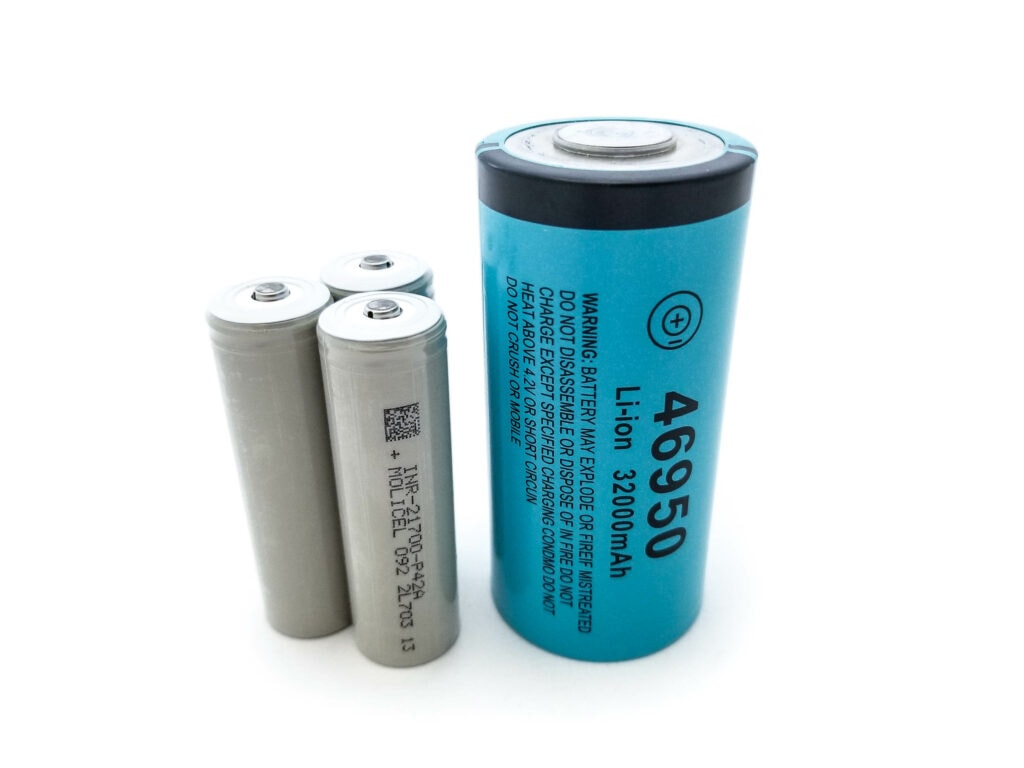
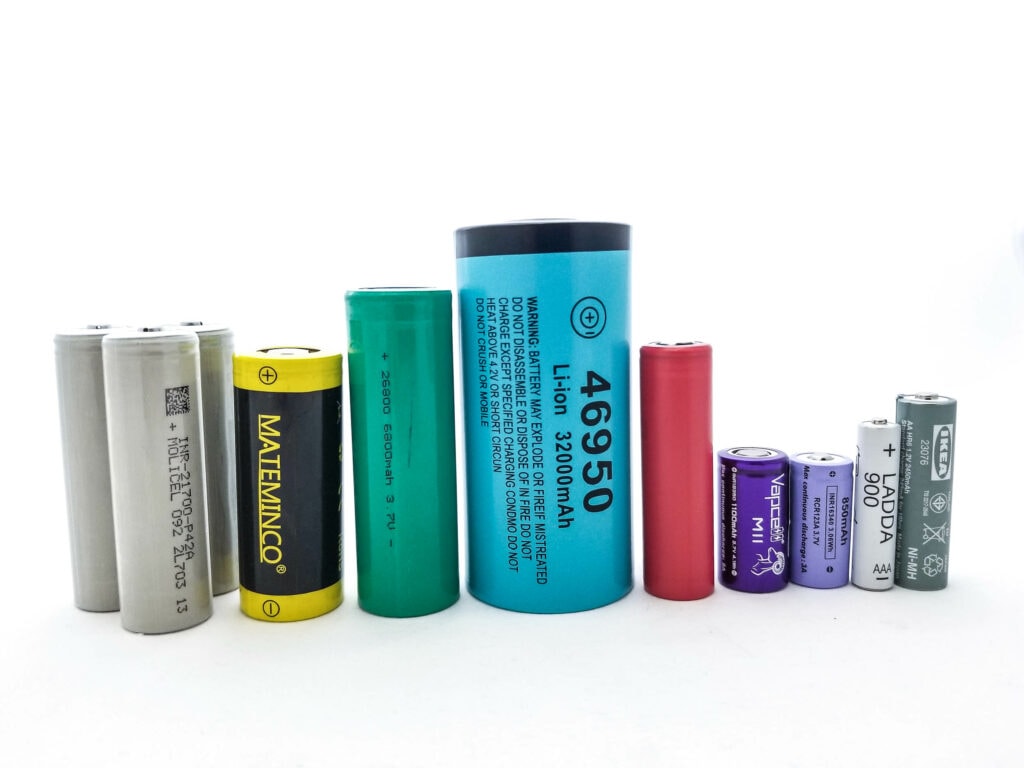
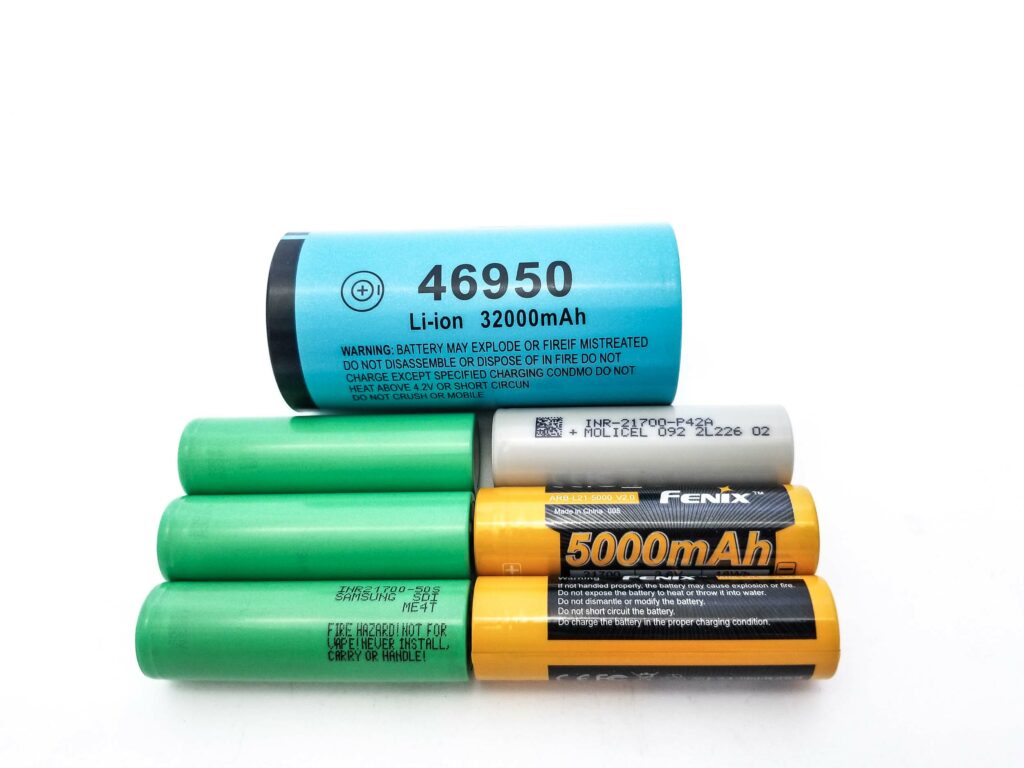

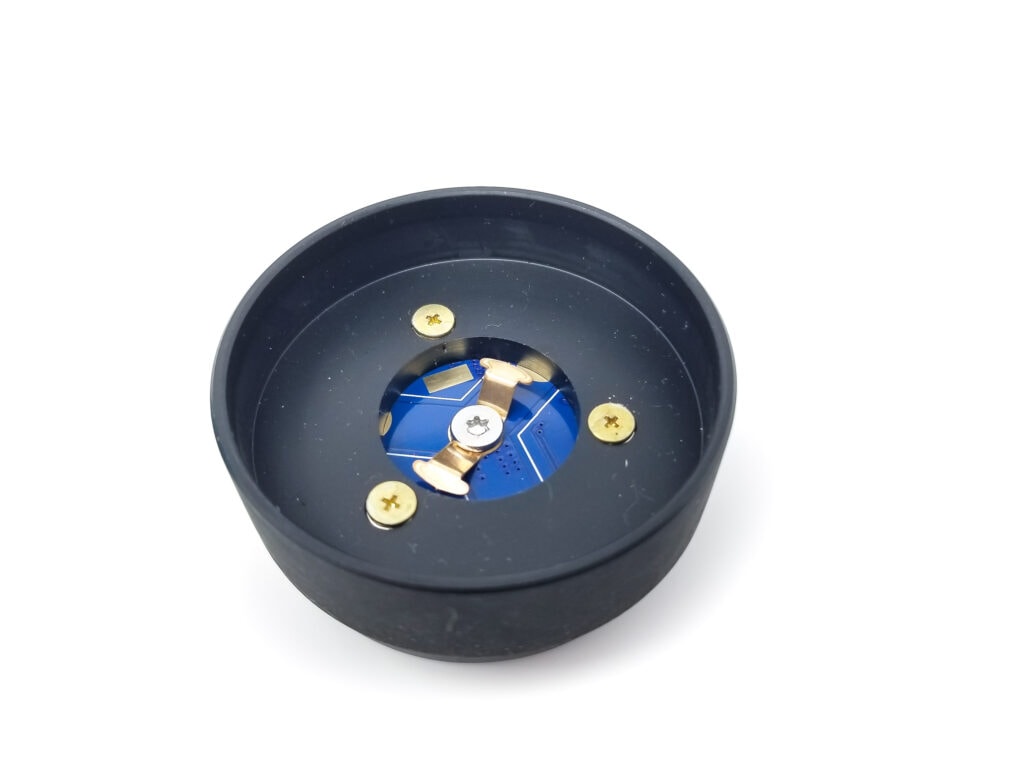
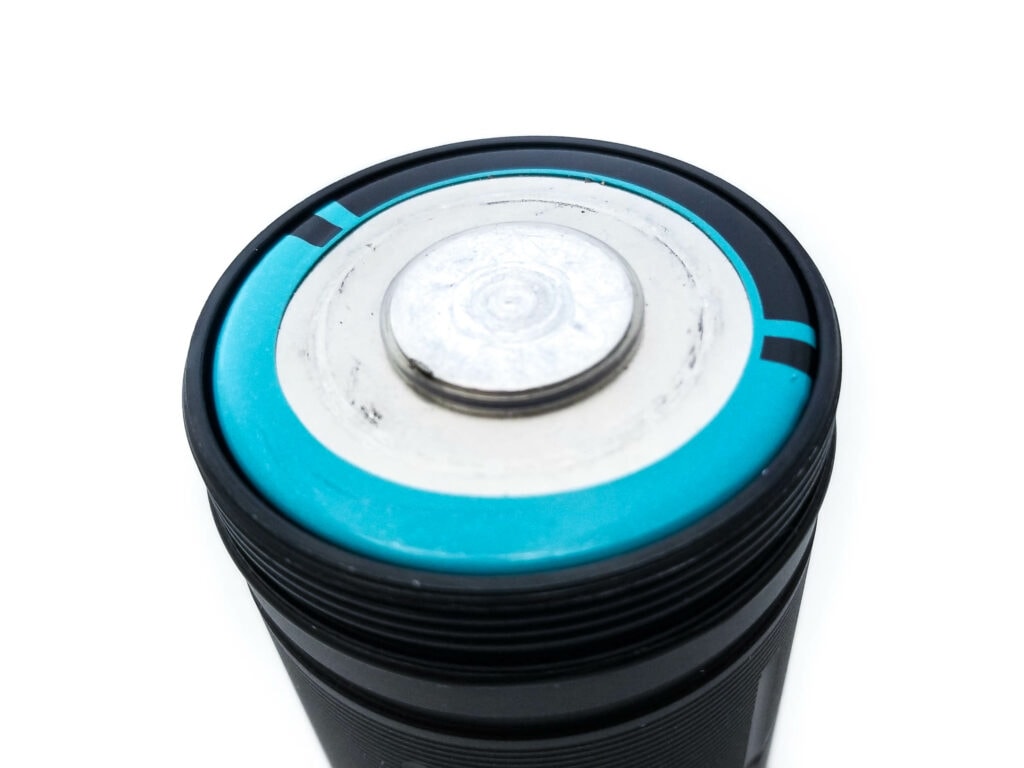
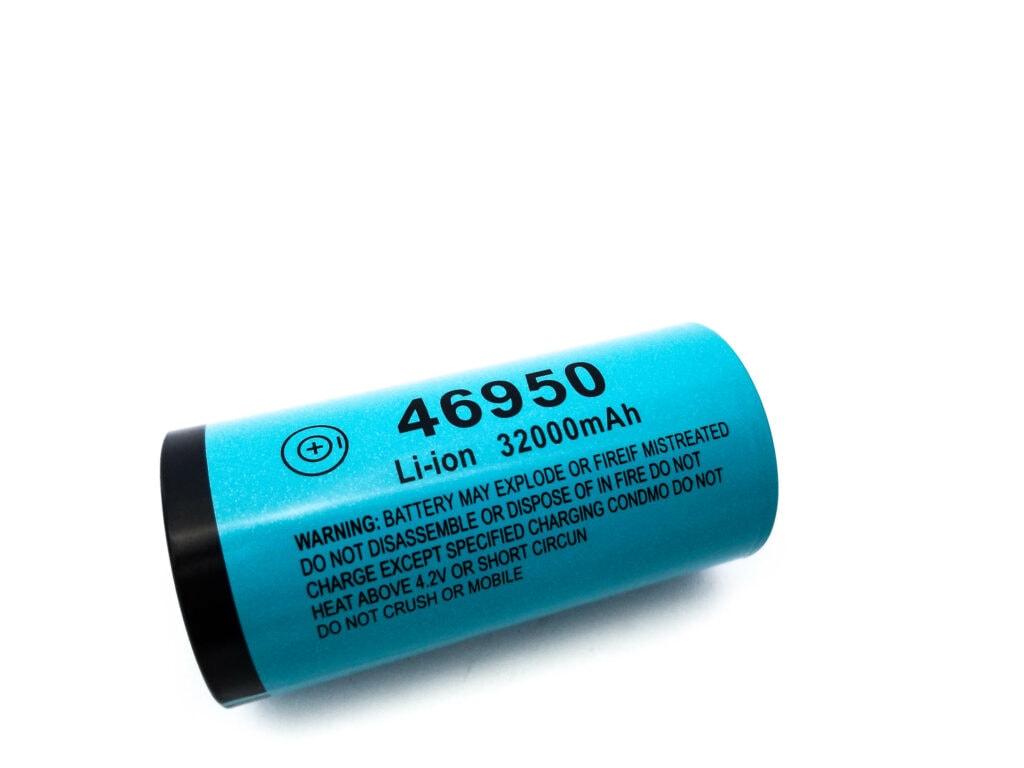
Performance test
Lumen measurements
How Lumens are Measured: Understanding ANSI FL1 Standards How Lumens are Measured: Understanding ANSI FL1 Standards: The ANSI FL1 standards specify that output in lumens should be measured 30 seconds after turning on, as this is the standardized time for measuring brightness according to the industry standard. This is why we focus on this part in our measurements. The ANSI FL1 standards require an ambient temperature of 22 ± 3°C. We record the ambient the ambient temperature to identify potential reasons for any observed discrepancies.Lumens are measured in my integrating tube made from a 4-inch to 3-inch closet elbow and two 3-inch street 90 with an end cap. I use a Digi-Sense 20250-00 data logging luxmeter. The tube has been calibrated with a Convoy S2+ measured to 260 Lumens and the figures are within 10% of actual. No current readings this time since the current path is weird due to the dual switches. I used the fully charged Amutorch branded 46950 battery for the test.
| Mode | Specs | turn on | 30 sec | 10 minutes |
|---|---|---|---|---|
| Eco (?) | ? | 178 lm | 178 lm | – |
| Low | 330 | 217 lm | 217 lm | – |
| Medium | 610 | 471 lm | 471 lm | 471 lm |
| High | 1500 | 1121 lm | 1113 lm | 1094 lm |
| Turbo | 3500 | 2698 lm | 2318 lm | 1026 lm |
I pulled these specs off Nealsgadgets site since there weren’t any on Amutorch’s website. Curiously, there’s an additional mode accessed when long-pressing the switch from off. It’s riddled with PWM though, and a bit dimmer than the Low mode you get when clicking on from off. This might actually be the bottom of the ramp for the smooth ramp mode.
The SBT90.2 version of the DM90S is rated for 6000 Lumens at Turbo, so I’m getting half that. Still, the output from the neutral/warm white RC90 LED isn’t bad at all and more than the original SBT70 could muster (back in 2015) even when driven pretty hard. Still, nowhere near as bright as the SBT90.2.
Amutorch DM90S Battery Life: Runtime graphs
How Runtimes are Measured: Understanding ANSI FL1 Standards About ANSI FL1 runtime standards: The runtime is measured until the light drops to 10% of its initial output (30 seconds after turning on). This does not mean that the flashlight is not usable anymore. The last column shows how long the light actually works till it shuts off. If there is a + symbol, it means that the test was stopped at that particular point, but the light was actually still running. This happens on certain occasions, with certain drivers, firmware, or batteries.Runtimes are measured in my integrating tube made from a 4-inch to 3-inch closet elbow and two street 90s with an endcap. I use a Digi-Sense 20250-00 data logging luxmeter. The tube has been calibrated with a Convoy S2+ measured to 260 Lumens and the figures are within 10% of actual. I measure temperature readings with my Digi-Sense 20250-92 data logging thermocouple. The thermocouple is affixed to the head with kapton tape, and I used the same 5 second sampling rate as the luxmeter. I used the included 32,000 mAh 46950 battery for the test. I only sampled temperatures for Turbo mode.
| Mode | Specified runtime | Measured runtime ANSI | Time till shut off |
|---|---|---|---|
| Medium | ? | 24h | 24h+ |
| High | ? | 9h 35m | 9h 35m |
| Turbo | ? | 9h 13m | 9h 13m |

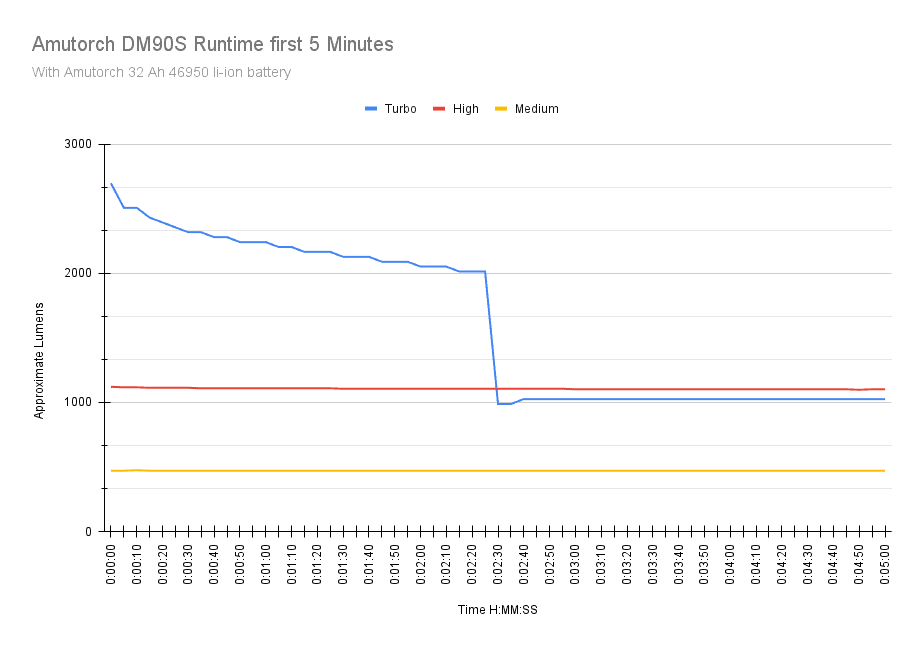
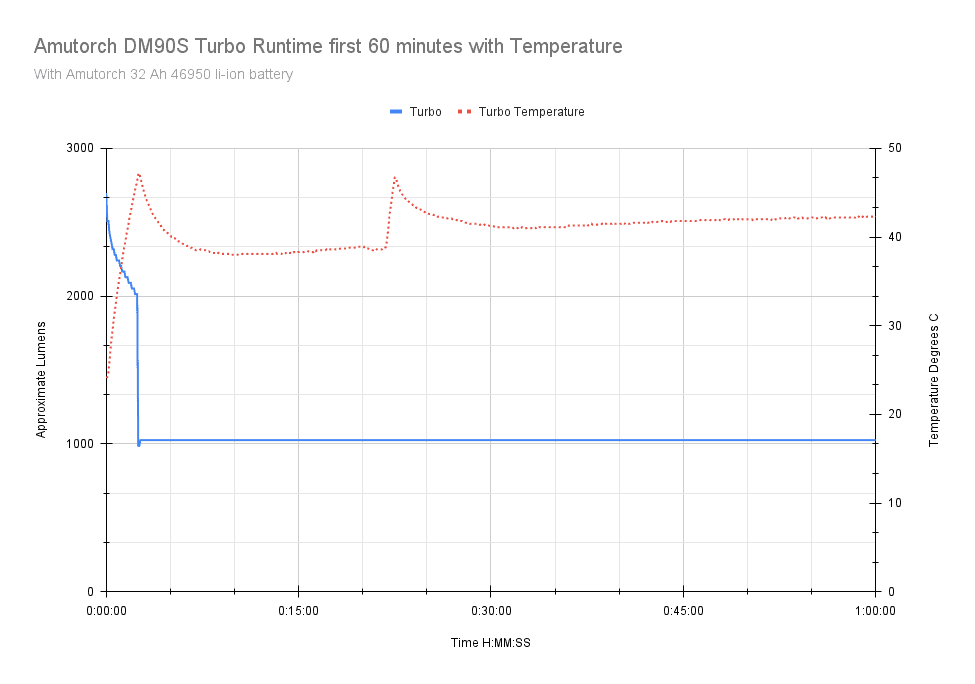
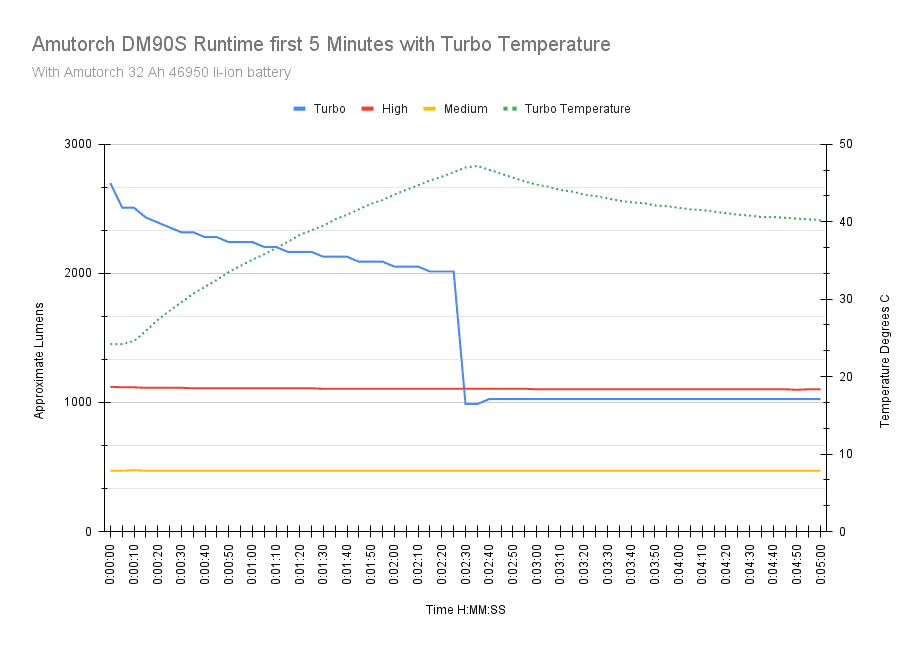
The light didn’t come with instructions, and there weren’t any specs on Amutorch or even Nealsgadgets for the RC90 LED version of this light. I was expecting long runtimes thanks to the humongous battery, and I did. There seems to be a timed step down for the Turbo mode, a slight drop that happens around 10-15 seconds to around 2200 Lumens, then another drop around the 2 minute 30 second mark to roughly High mode Turbo can be reactivated after the drop, but the timer kicks in after 15 seconds and kicks it down to High mode output.
You get roughly 1100 Lumens for over 8 hours for both Turbo and High modes. Yah, I’d call that impressive, and they’re all very stable with no thermal intervention with laminar outputs, indicative of a buck driver. The highest temps I saw was around 50 C near the head, and it’s totally hand-friendly even for the duration of Turbo mode.
Medium mode ran, and ran, and ran…I think they stuffed Forrest Gump in the battery because it just kept going. I ended the test at 24hrs. mark because the output hadn’t budged. You get a drop to about 300 Lumens with visual LVP blinks that lasted for a while before the light shut off. You could use the light on reduced output after LVP. The battery read about 2.89 volts after the other runtimes.
I threw together a comparison graph with some other long-range high output lights, including the DM90. While the SBT90.2 equipped WT90, DM90 (both 3×21700 lights), and the Wurkkos TS30S (which is a single 21700 light) beat the RC90 DM90S for output, the 46950 cell coupled with the buck driver helps the DM90S trounce them in terms of sustained output and runtimes. There’s ample heatsinking here for higher output, and I’d be really curious to see how an SBT90.2 performs behind the big cell. An impressive performance for the DM90S.
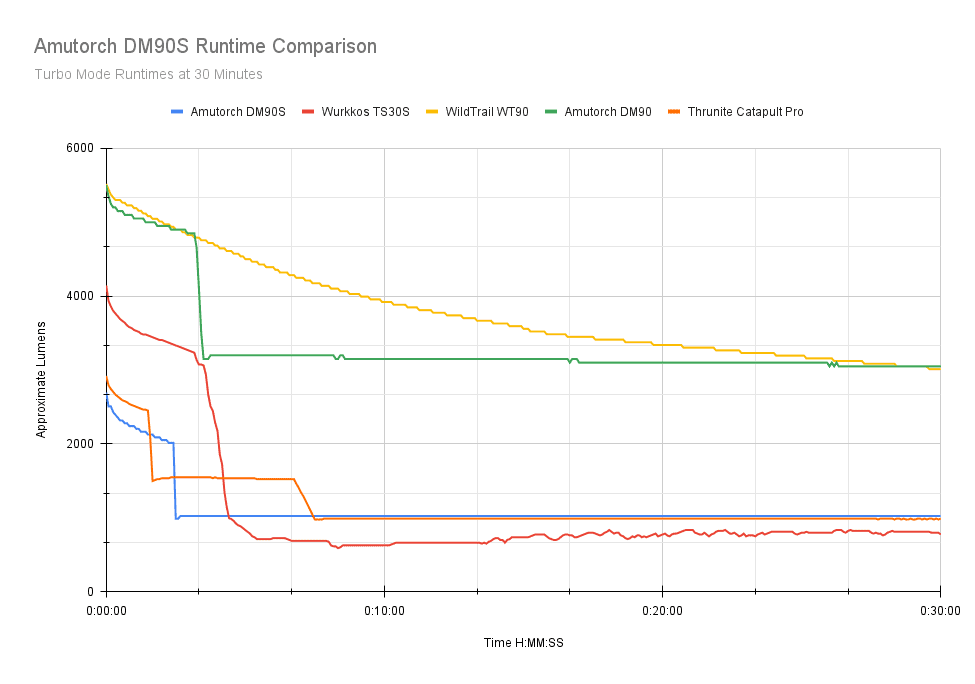
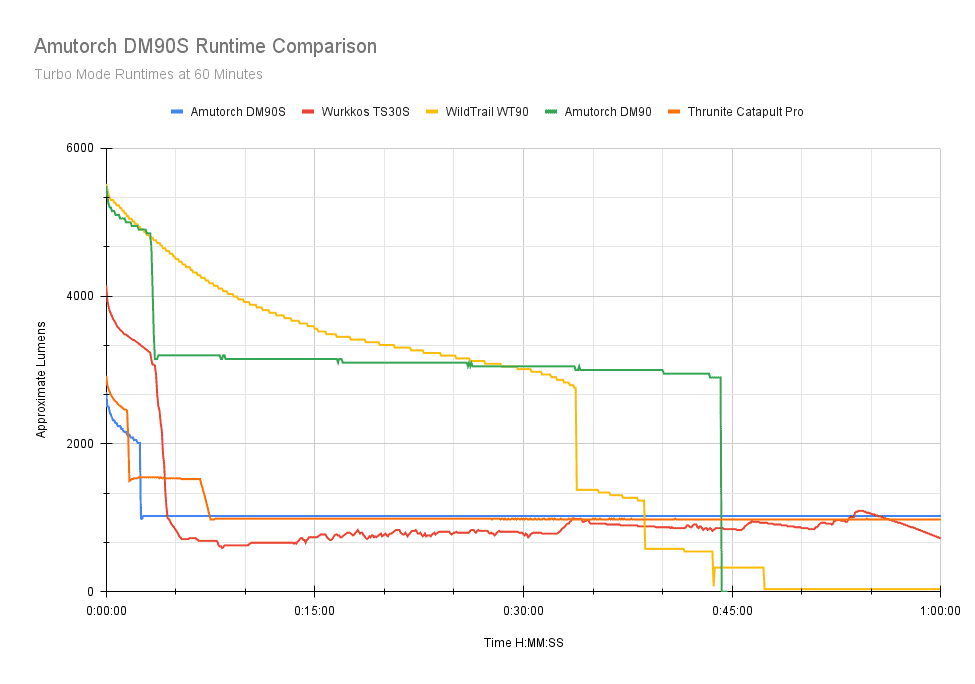
Peak beam intensity and beam distance measurements
About Peak beam intensity: Understanding ANSI FL1 Standards About peak beam intensity The calculated value of distance in meters at which the flashlight produces a light intensity of 0.25 lux. (0.25 lux is about the brightness of a full moon shining on an object). This means that the intensity has decreased so much, it becomes difficult to see darker objects, or objects that don’t reflect light. The columns ‘Meters’ and ‘Yards’ use rounded numbers.The beam distance test was conducted using a Uni-t UT383S luxmeter outdoors at a distance of 10 meters. I used the included 46950 battery for the test. Measurements taken at 30 seconds per ANSI spec.
| Mode | Specs | Candela measured | Meters | Yards |
|---|---|---|---|---|
| Low | ? | 55,600 | 472 | 516 |
| Medium | ? | 108,500 | 659 | 721 |
| High | ? | 269,300 | 1,038 | 1135 |
| Turbo | 640,000 cd | 545,700 cd | 1,477 | 1615 |
| Turbo at turn on | ? | 587,500 | 1,533 | 1676 |
There’s no throw figures/specs listed for this light, save for a lone Turbo figure of 640,000 cd and 1600 meters (again, pulled from Nealsgadgets). The SBT90.2 version of this light claims 1732 meters. For a neutral white (borderline warm white) LED, this is good performance. Still off from the advertised, but not terribly so and it seems brighter than it is.
Beamshots
Photos taken with my Samsung Note 8 set to 0.5s ISO 400 and 5000K WB. The water tower is about 950 meters distant. The closest competitor to this light is the WildTrail WT90, a roughly 99 mm diameter head.
Beamshots of the following flashlights compared:
- WildTral WT90
- Amutorch DM90
- Amutorch DM90S
- Acebeam L19 V2
- Haikelite HT90 (quad GT9090 LEDs)
- Thrunite Catapult Pro
Please note that beamshots are mainly intended to showcase the beam pattern and beam quality, rather than overall performance. These images are typically taken directly after activation, and do not fully represent its overall performance. For accurate performance metrics, such as output, beam distance, and runtimes, you need to look at the performance section of this review.
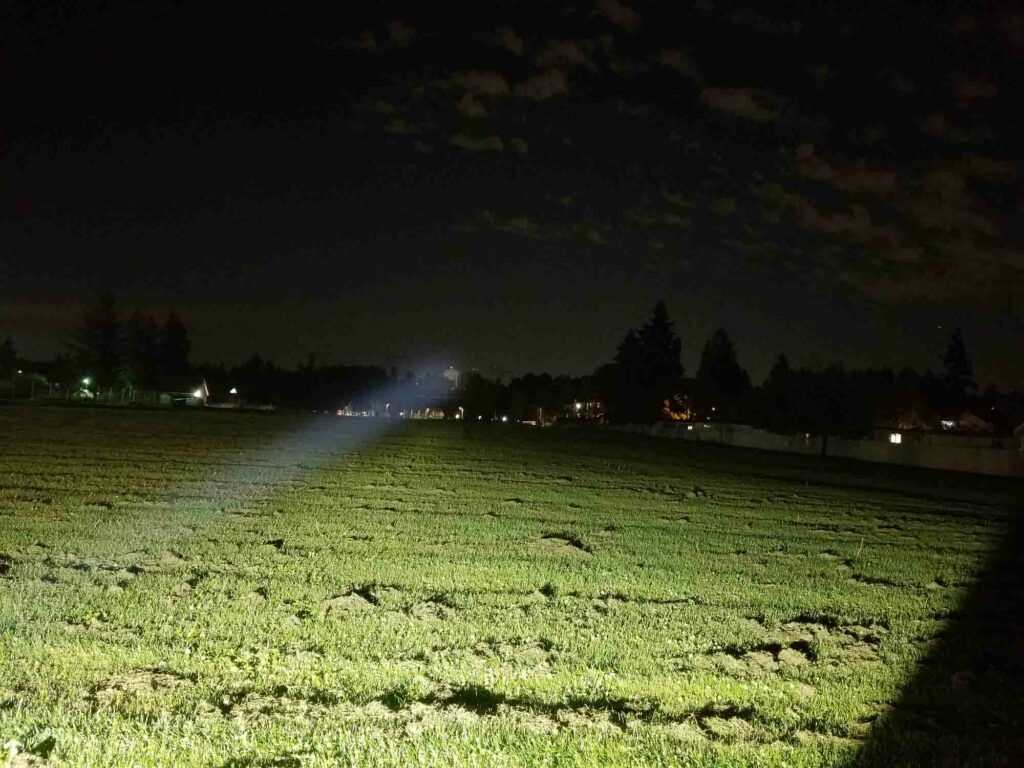
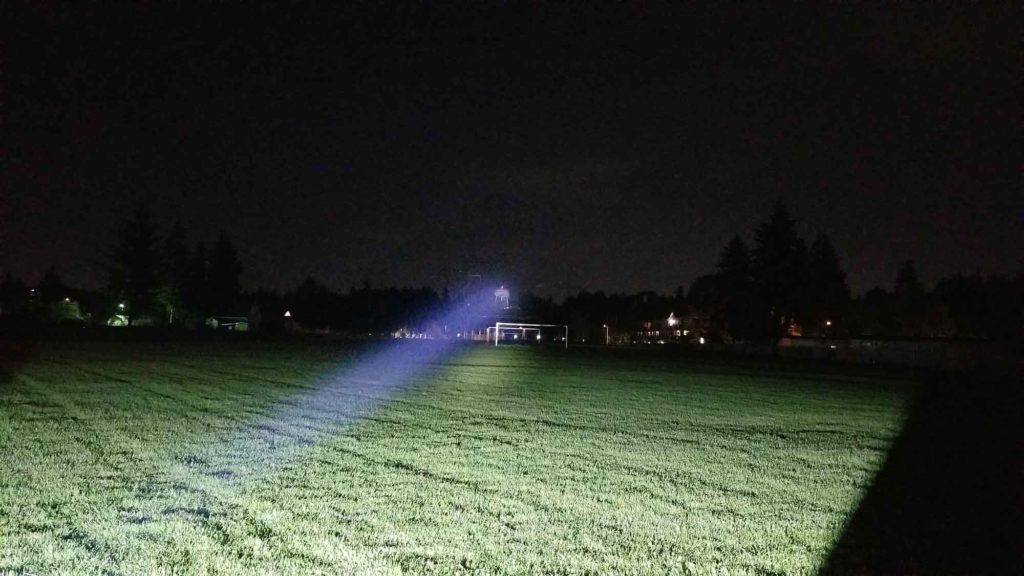

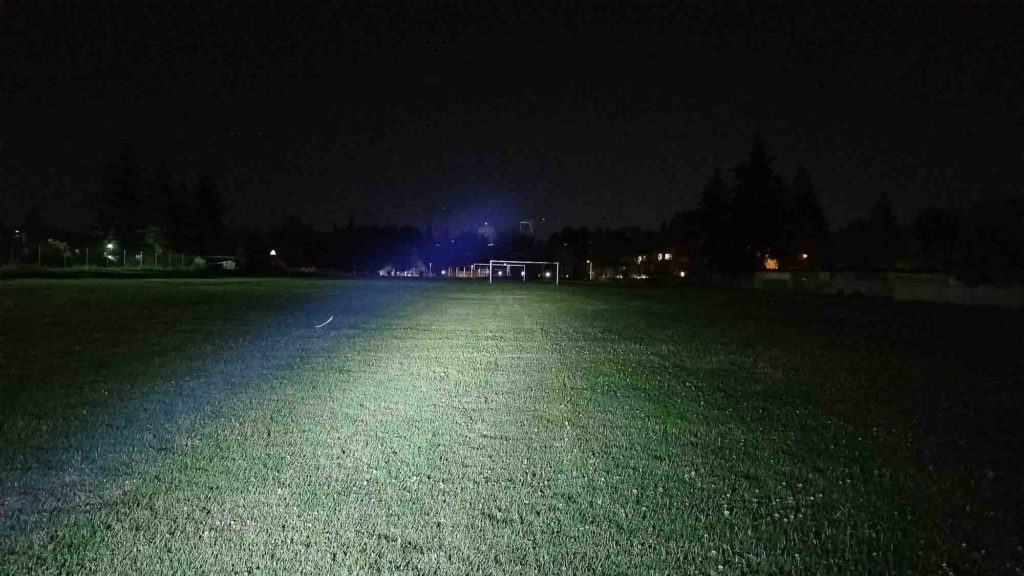
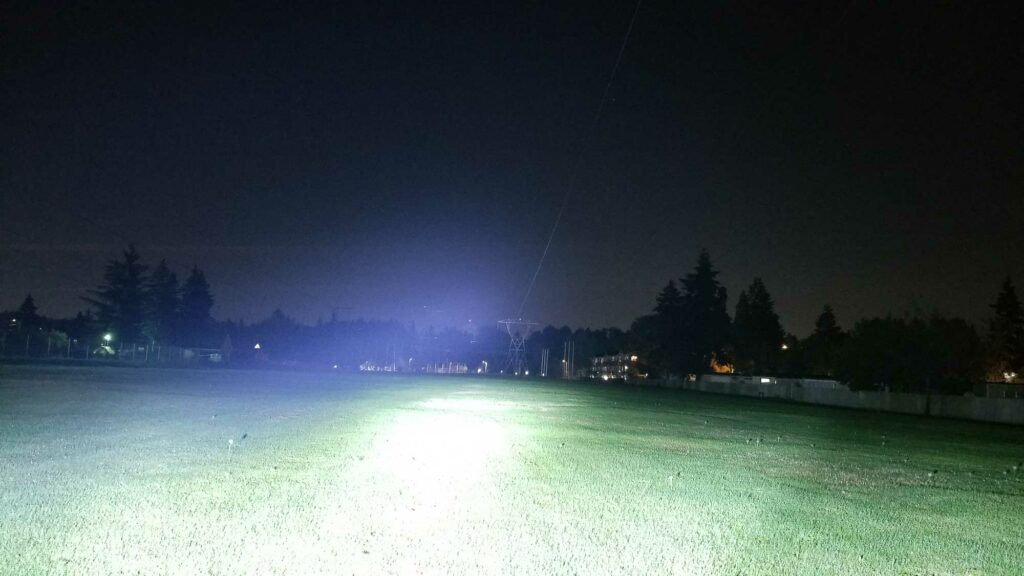
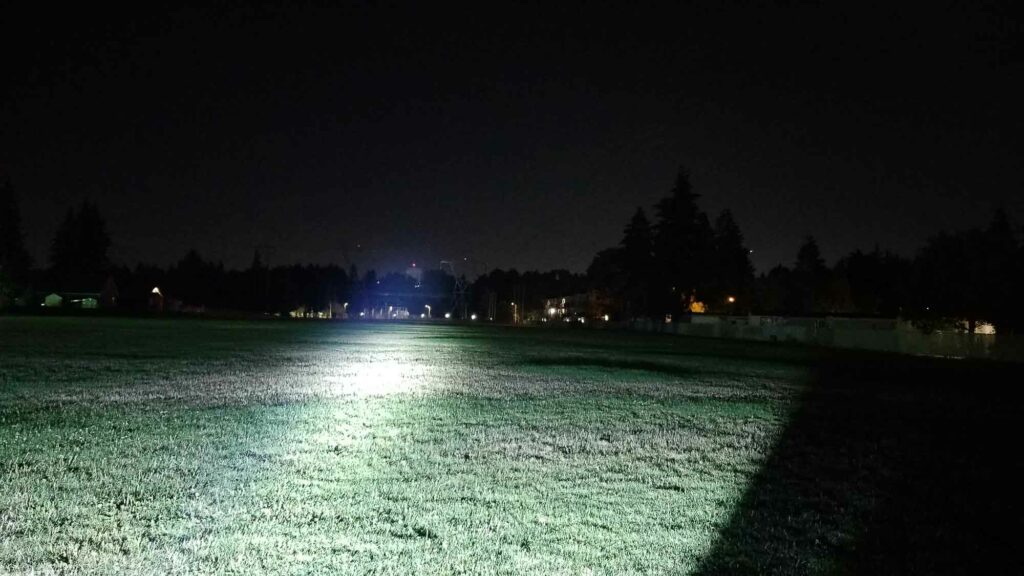
Disclaimer: This flashlight was sent to us for review at no cost by Nealsgadgets. We have not been paid to review, nor have we been holding back on problems or defects.
Final Verdict
Pros
- Decent build quality
- Nice performing Chinese SBT-70 clone
- Neutral white tint
- Fully regulated output
- Amazingly long and stable runtimes
- Big 32 Ah 46950 battery
- Compact form factor with handle
Cons
- A bit down from advertised specs
- Charging adapter maxed out at 20 watts (then burned up)
- Ringy beam
- Heavy
Explanation on star ratings:
1: Avoid: a match would be a better choice – 2: Poor: significant defect or issues; almost unusable – 3: Average: some defects or issues; but still usable 4: Good: recommended (minor issues) – 5: Great: highly recommended

4 stars: ★★★★
While our star rating provides a reliable indicator, we encourage you to read the full review to make an informed decision based on your own needs and preferences.
When I was asked to review a new, long-range mid size thrower from Amutorch with a huge battery, I jumped on it. Things just keep getting bigger and bigger, and batteries aren’t immune from that either. The DM90S started out as a 3×21700 soup can style thrower, a smaller version of the full-size DM90. That first light had the SBT90.2.
This review light with the clone-correct Luminus SBT70 ditched the 3×21700 carrier for a humongous, new, 46mm wide 95 mm long 32 Ah li-ion cell. It’s bigger, heavier, and doesn’t get as bright, or throw as far, but it trounces the SBT90.2 light (and just about every other mid-size thrower) in sustained output and runtime. Period. Everything else is pretty standard. While it’s heavier than other lights in this class, it handles like a mid-size soda can light, throws pretty good too. It seems brighter than my output tests suggest, and I’m glad you get the nice neutral tint (albeit low CRI). The build quality is very good, and you even get a decent buck driver. I like the simple UI with the somewhat-quirky dual stepped/smooth ramping mode from the other DM-series lights I tested.
What’s not so copasetic? The beam is really ringy, I’m down on output from specs, and a unique battery requires some creative changes to the charging and electrical path. Amutorch solved this with a proprietary cell layout and unorthodox charging solution. The sit-on-top charging adapter worked, but it only worked up to 20 watts, and worse, for two charge cycles then released the magic smoke and didn’t work any more. That’s a problem when the alternative is some creative bodgery with magnets, clips, and wires to jump it to an incompatible charger to charge the cell at 900-1100 mA, which takes a real…long…time.
I hope more manufacturers adopt this cell since it’s perfect for big, high output lights and improve the charging to cut down the recharge time. Should you pony up for this light? If you need a lower output, but still long throw light with a neutral CCT, huge battery, and ridiculously long runtimes (with mod potential), give the RC90 version a look. 4 stars for the RC90 DM90S.
Buy your Amutorch DM90S with a discount
Use one of the following 2 discount codes at Nealsgadgets: 1LumenNEW, or 1Lumen711
1lumen selects and reviews products personally. We may earn affiliate commissions through our links, which help support our testing.